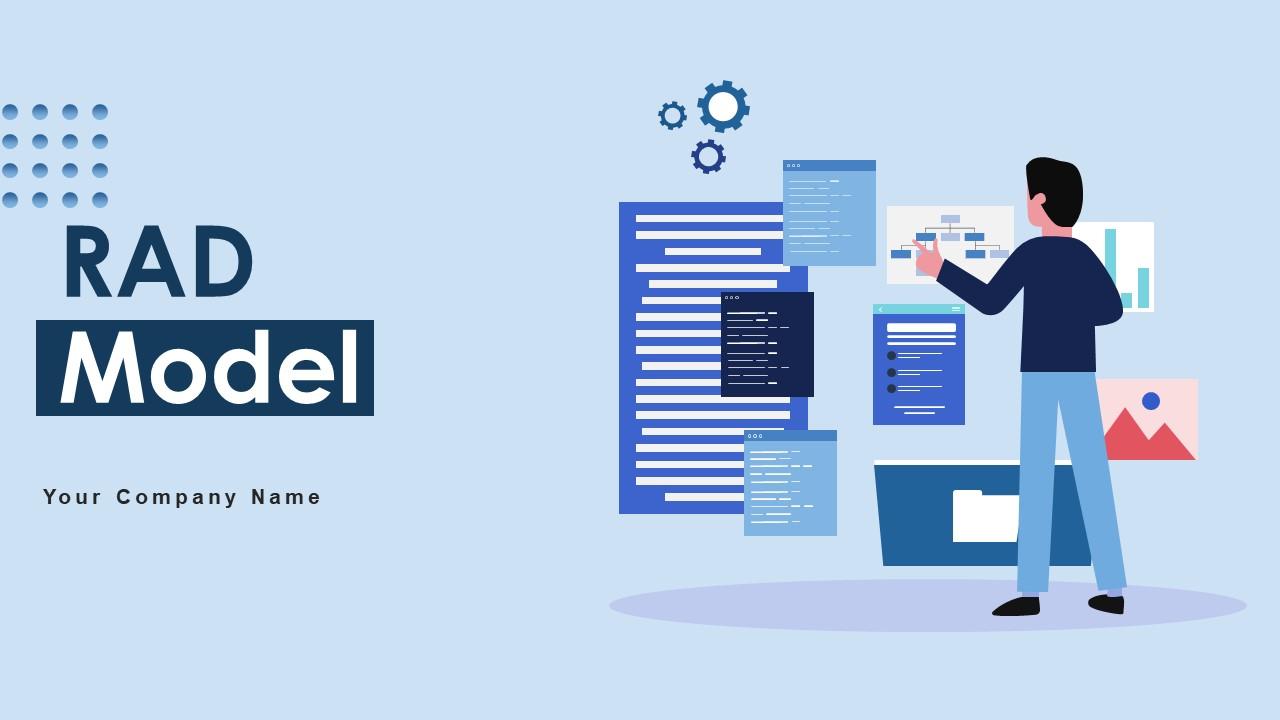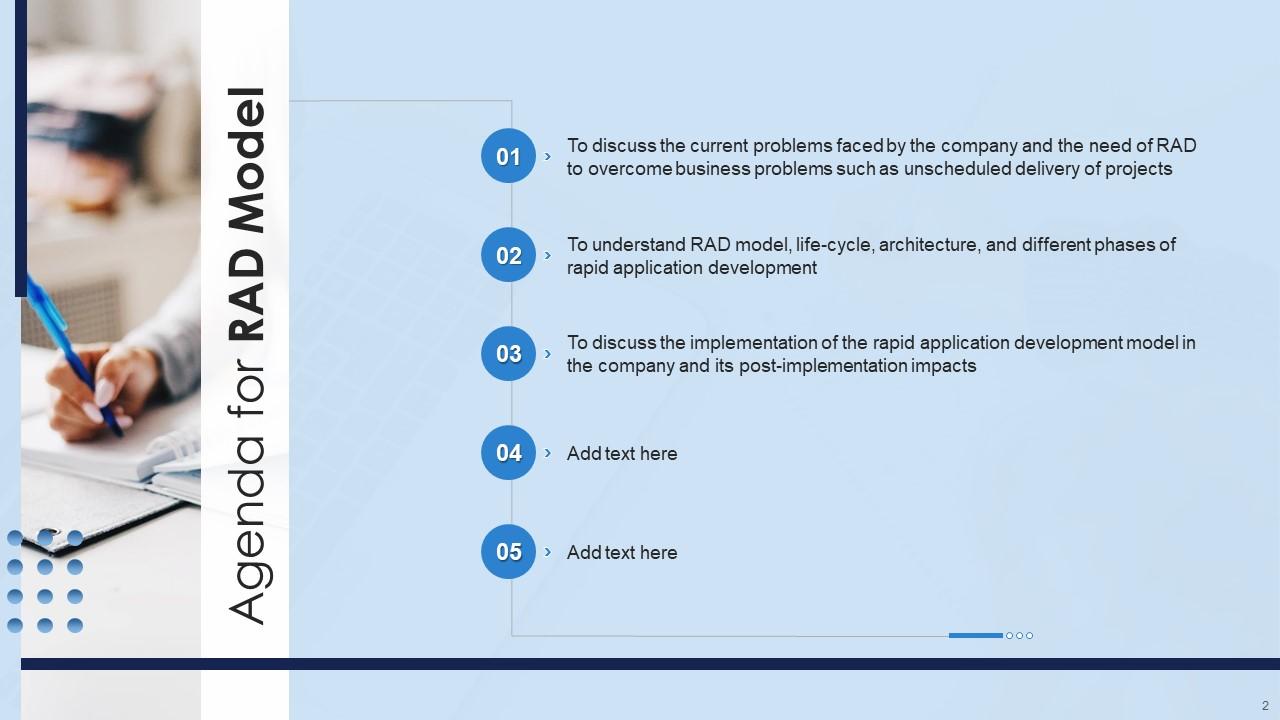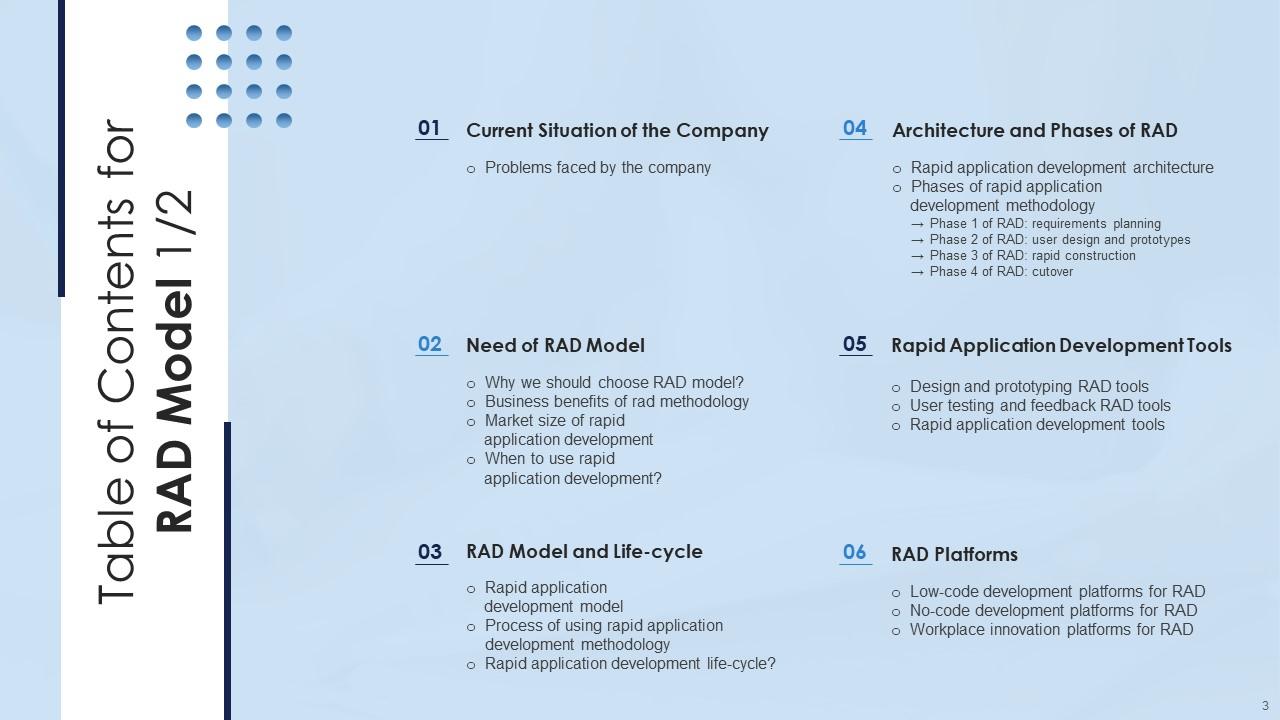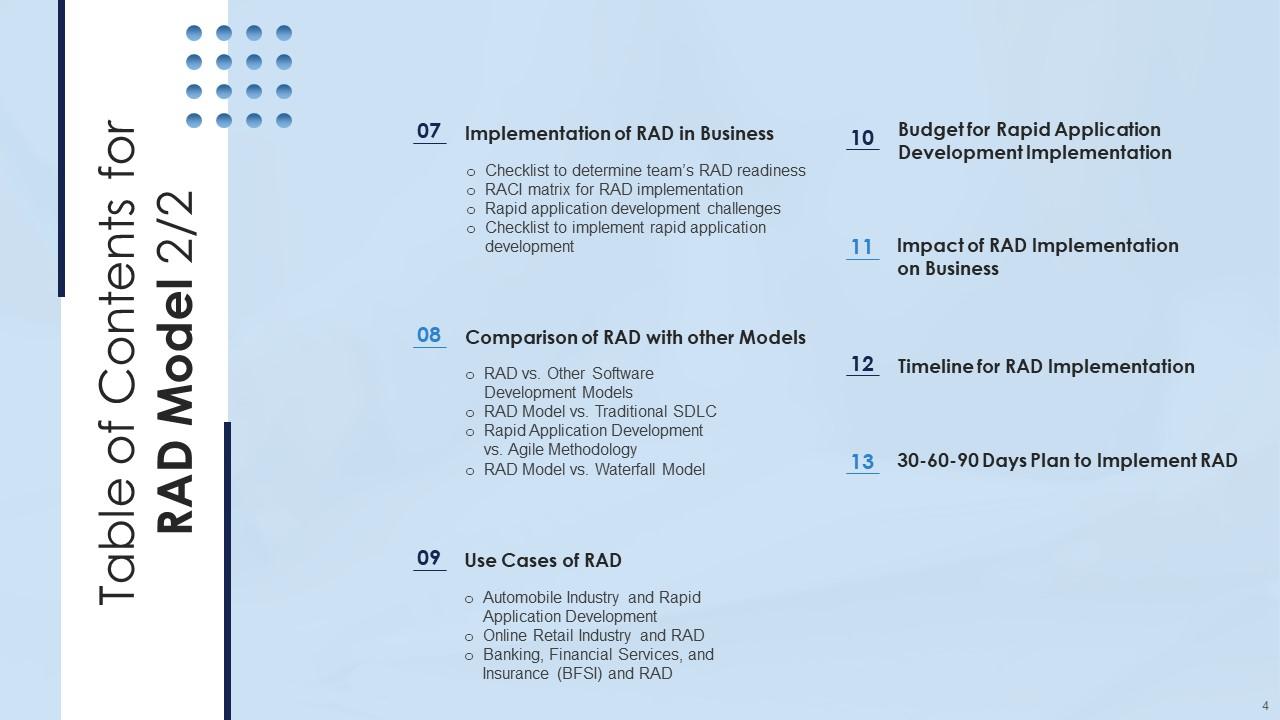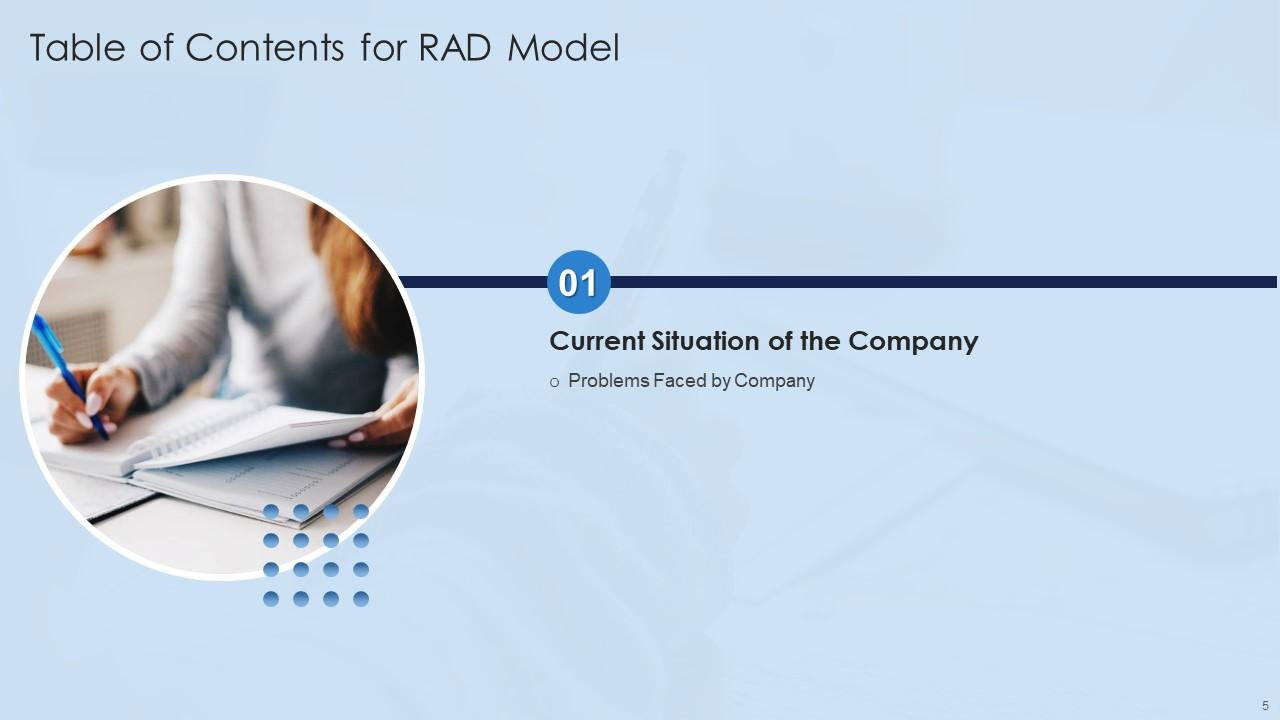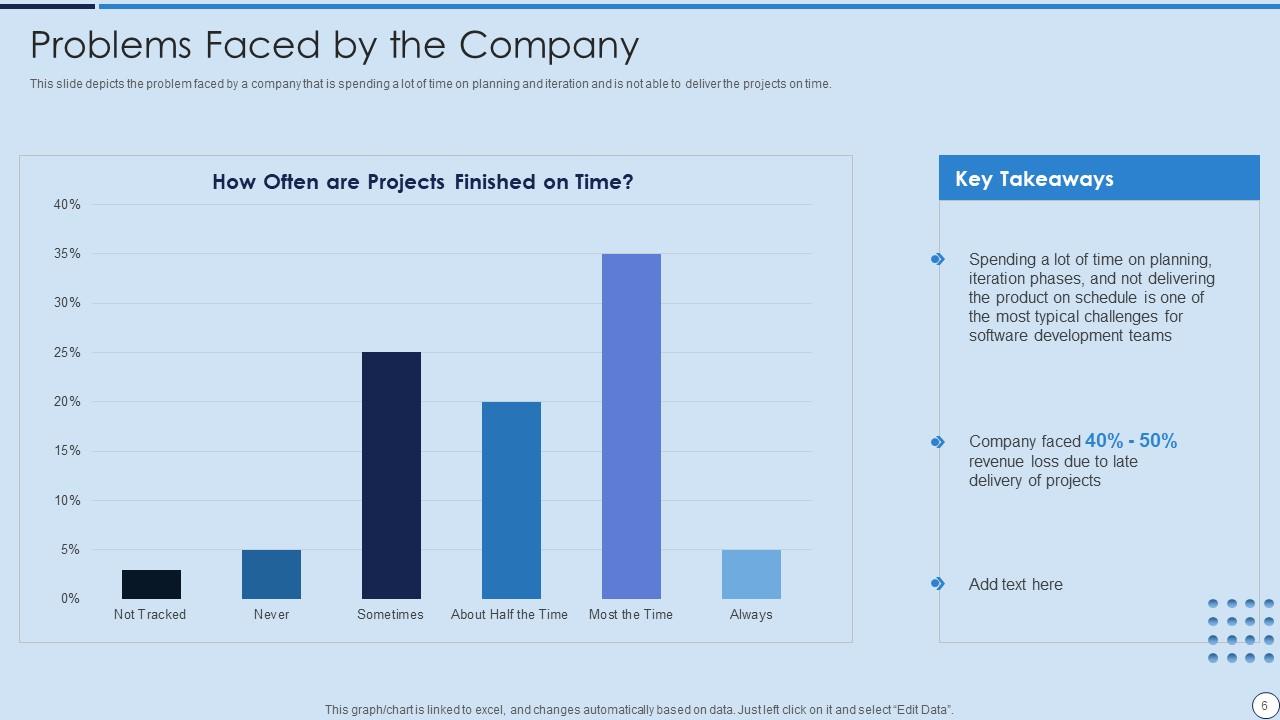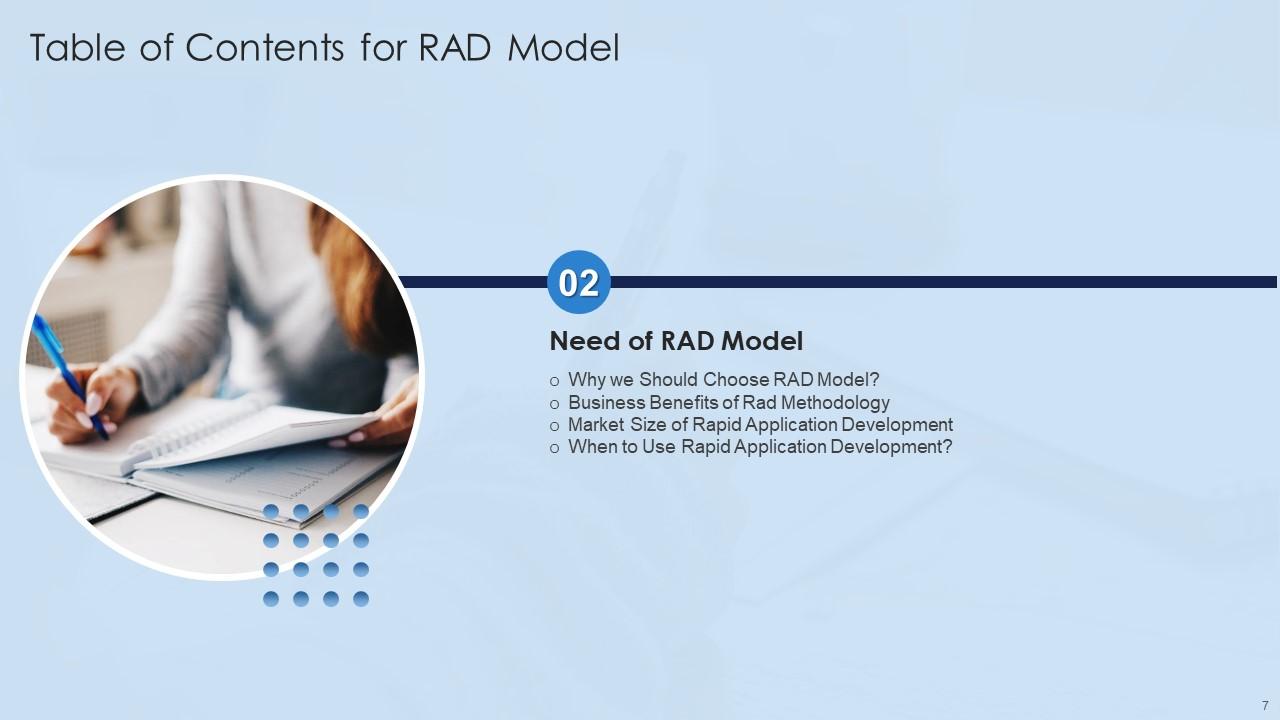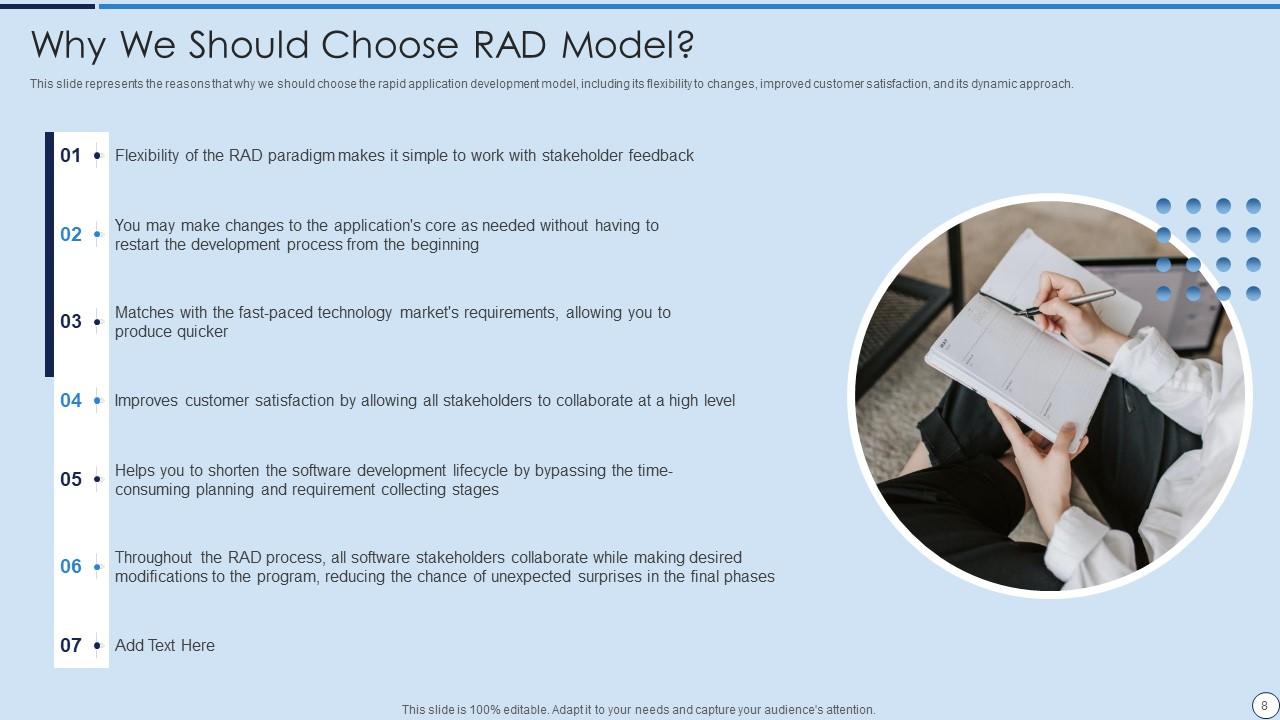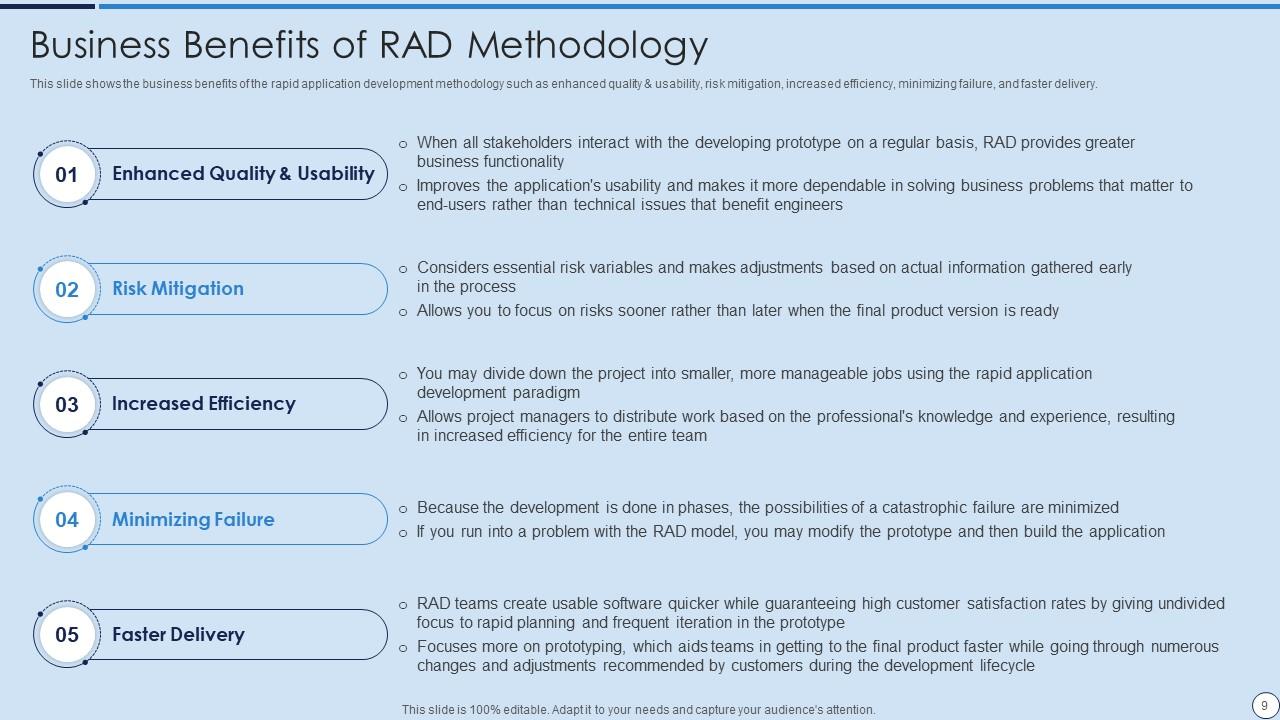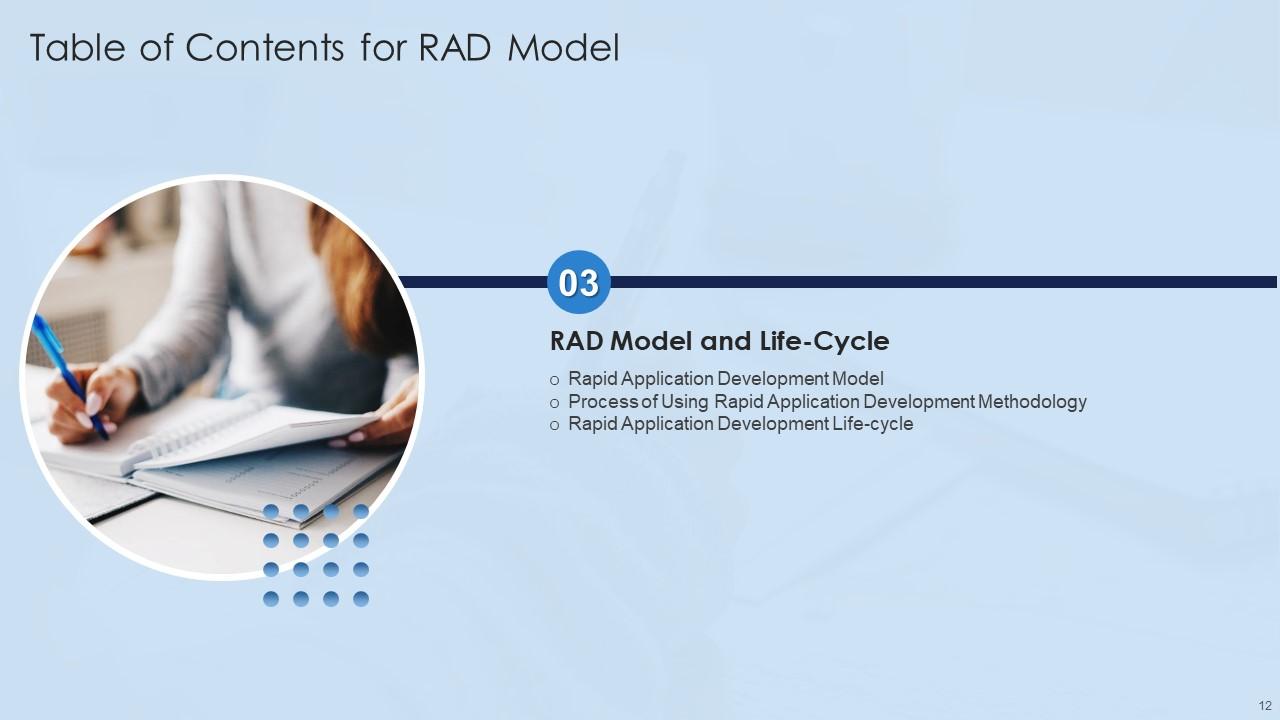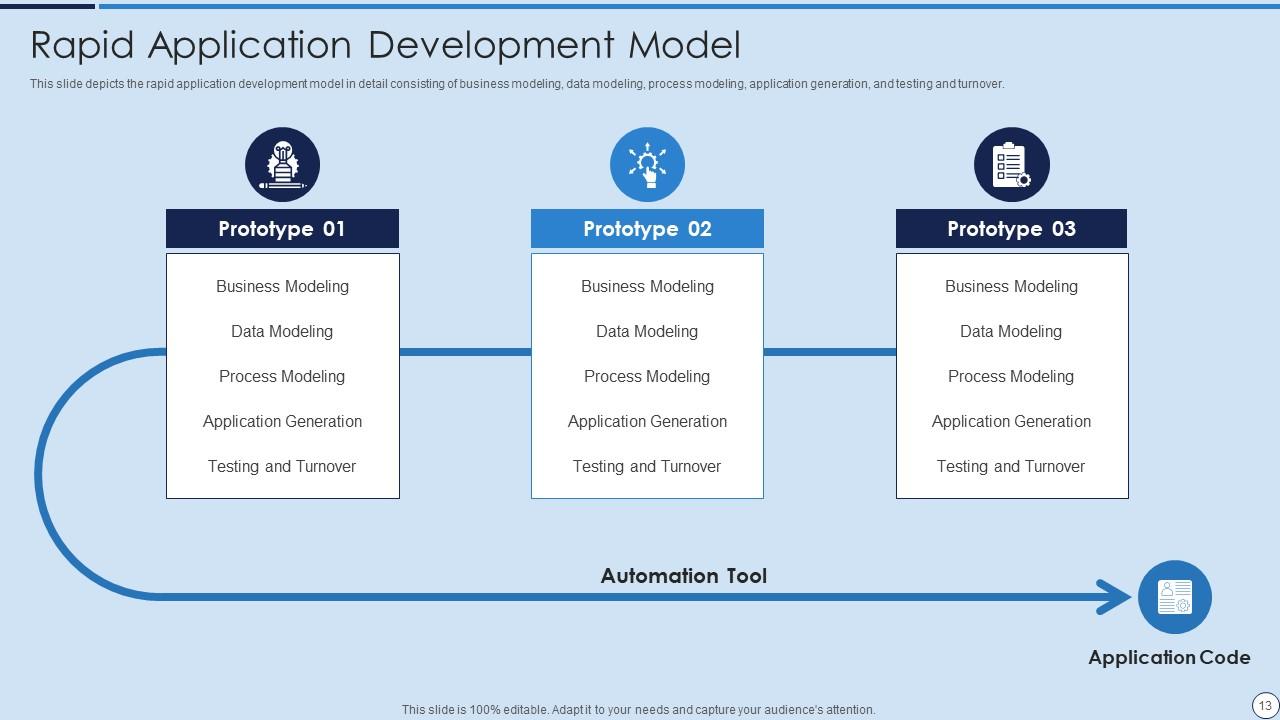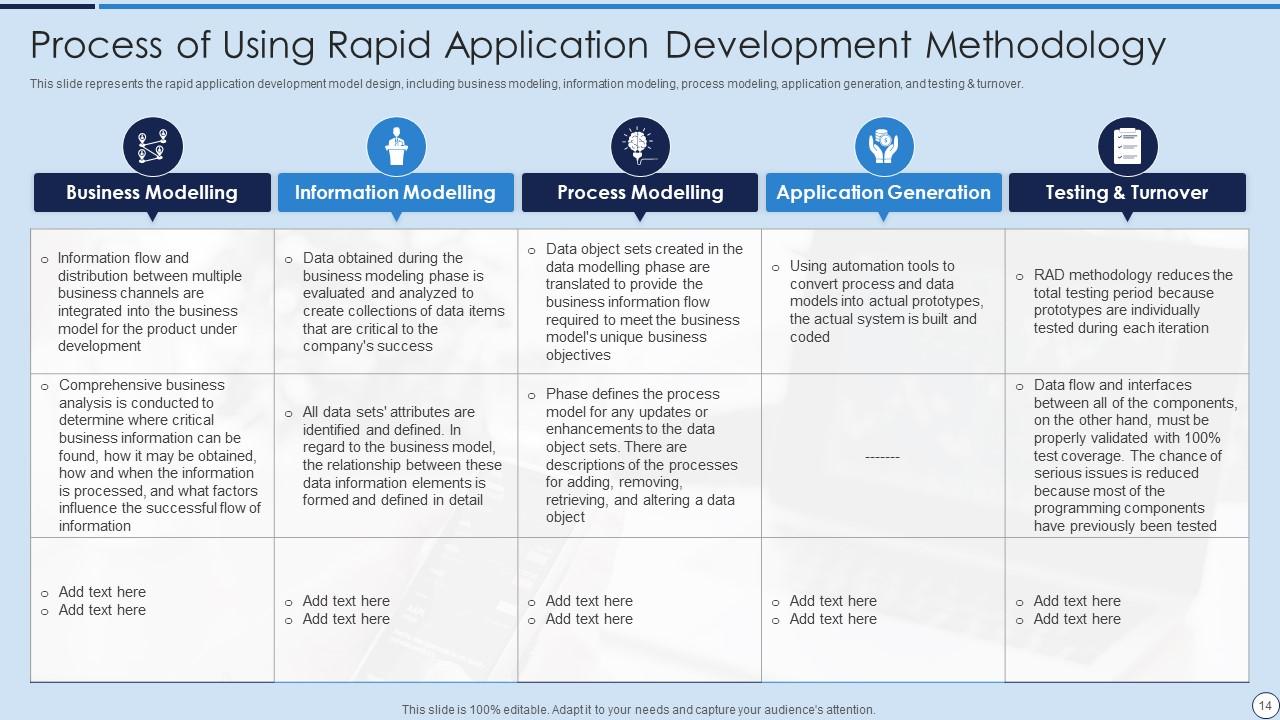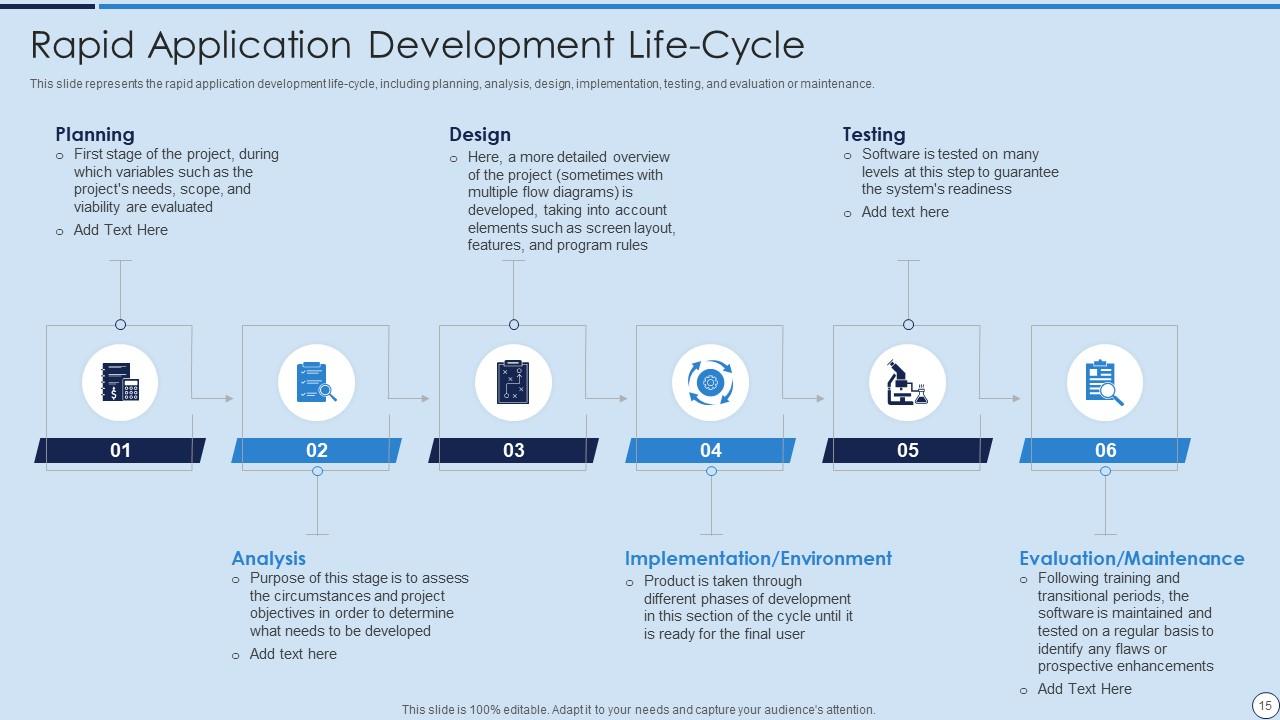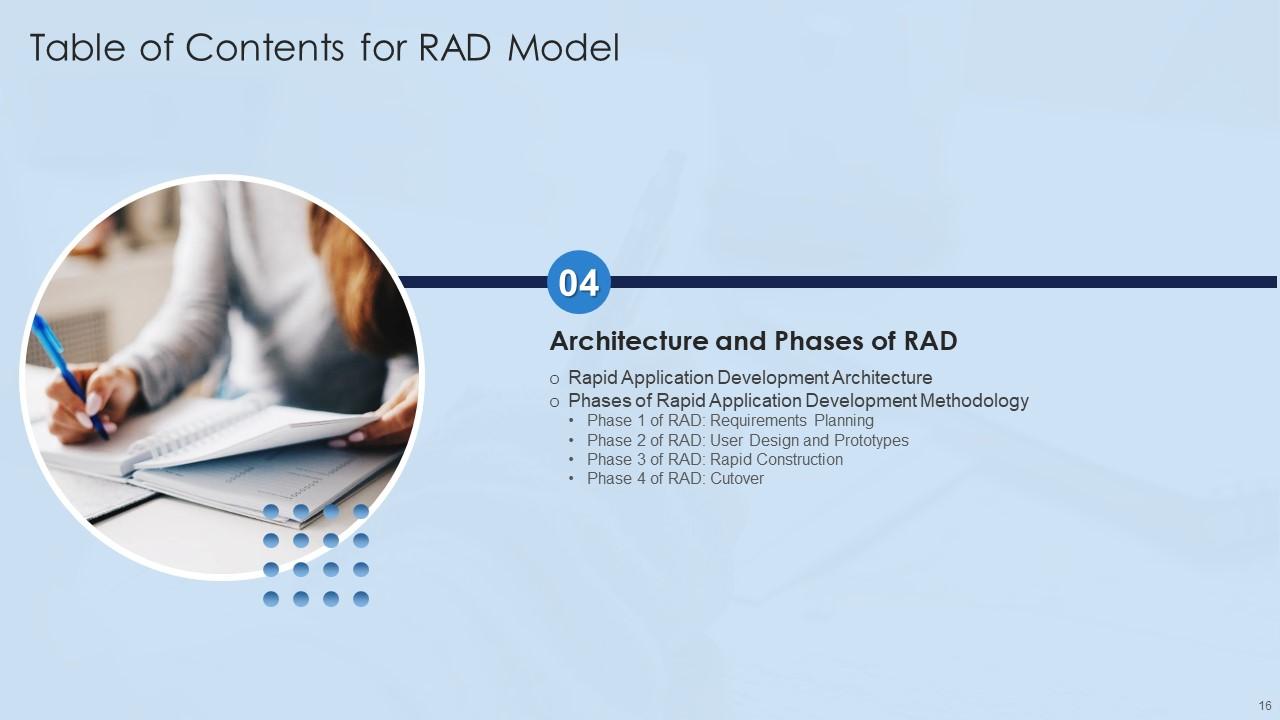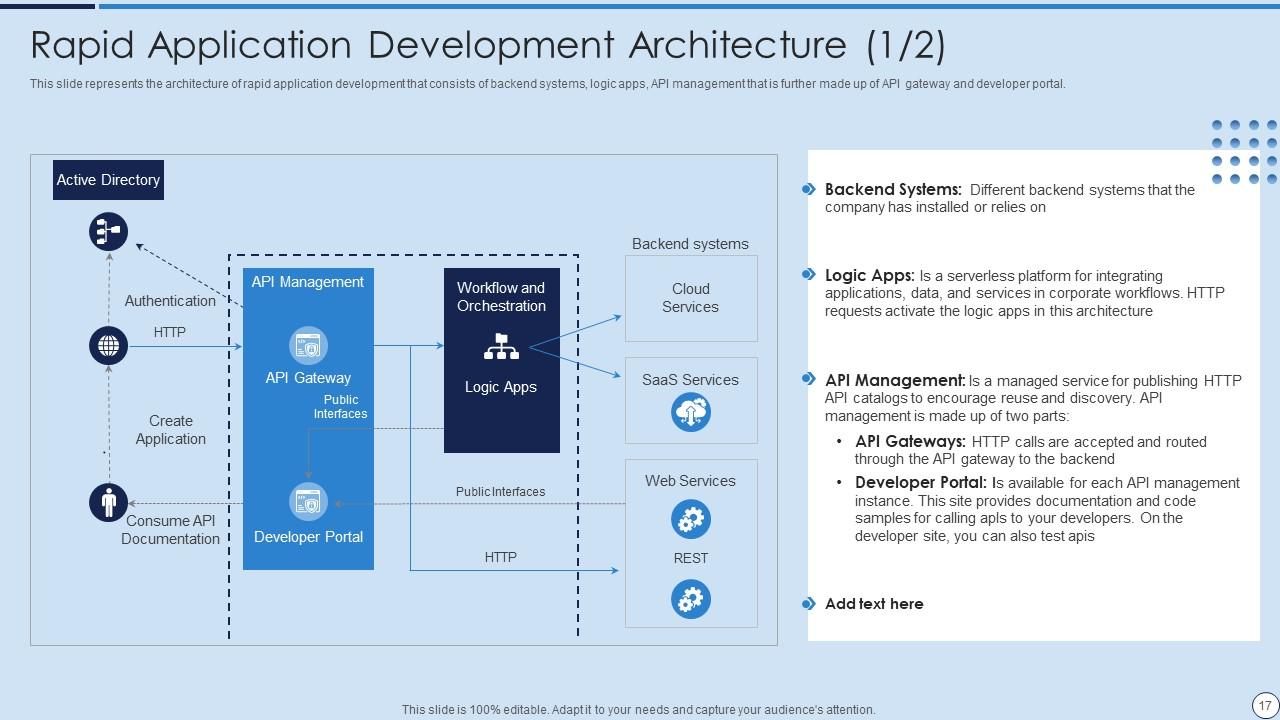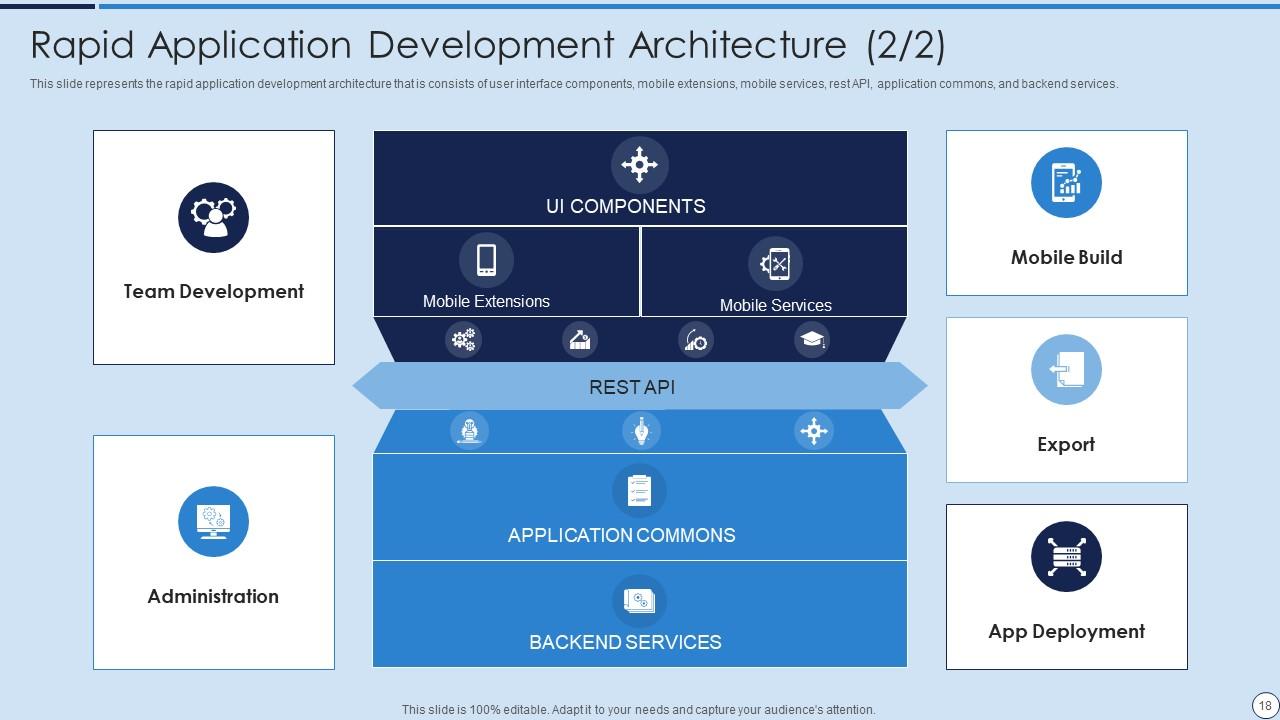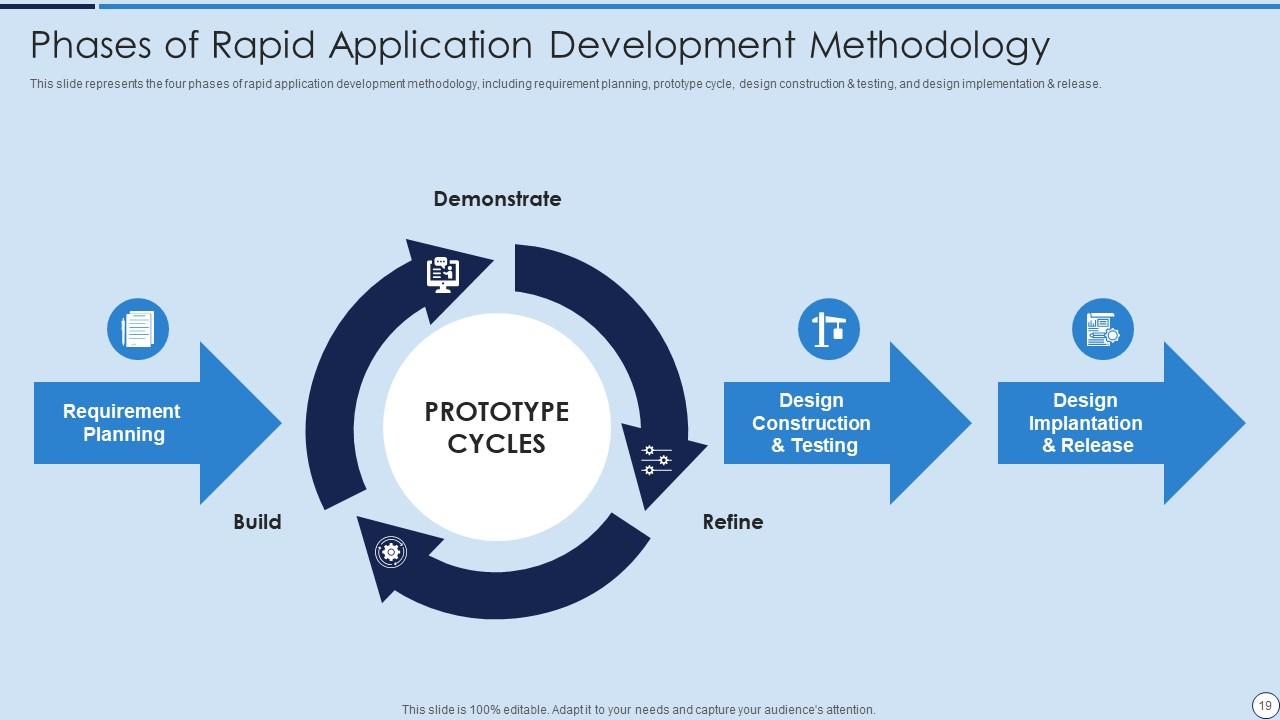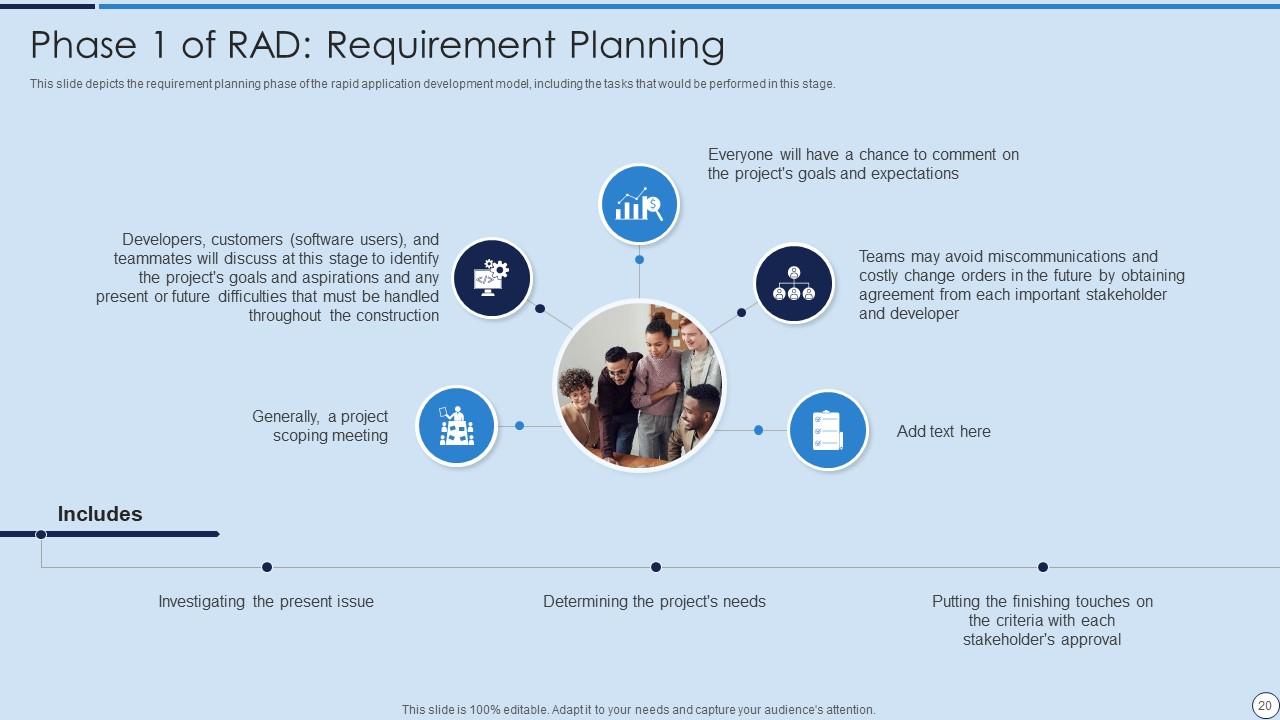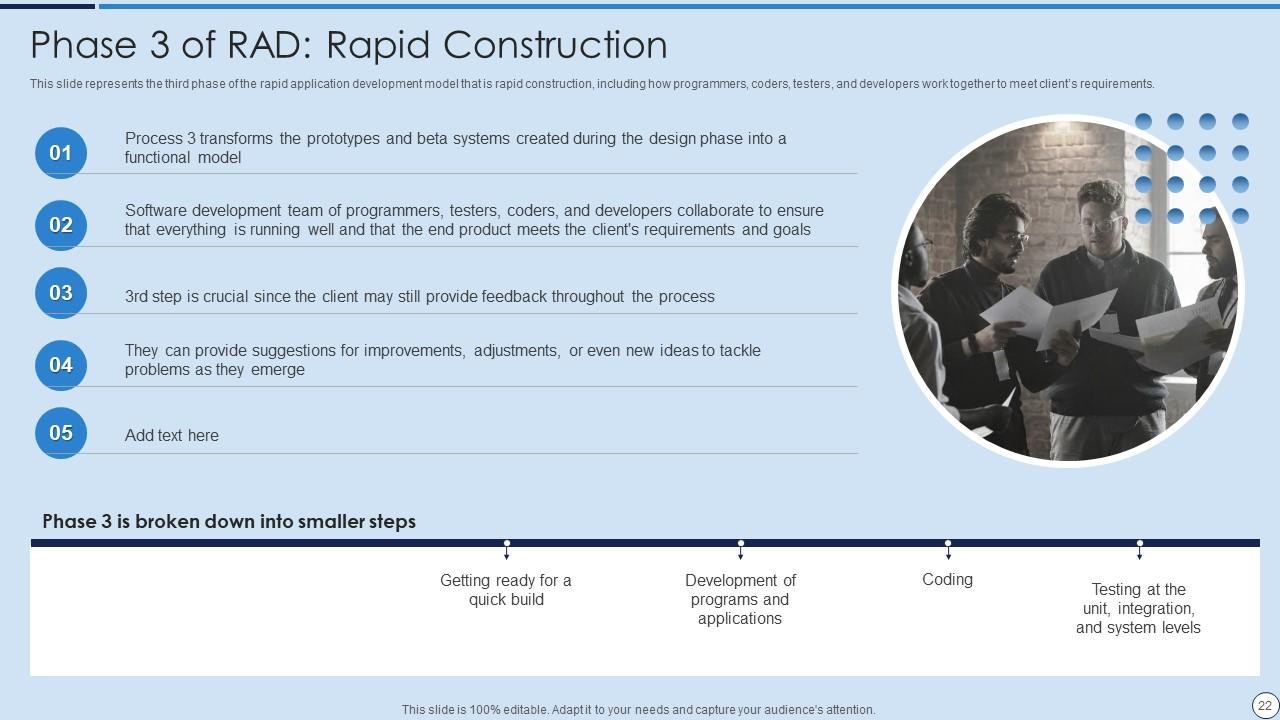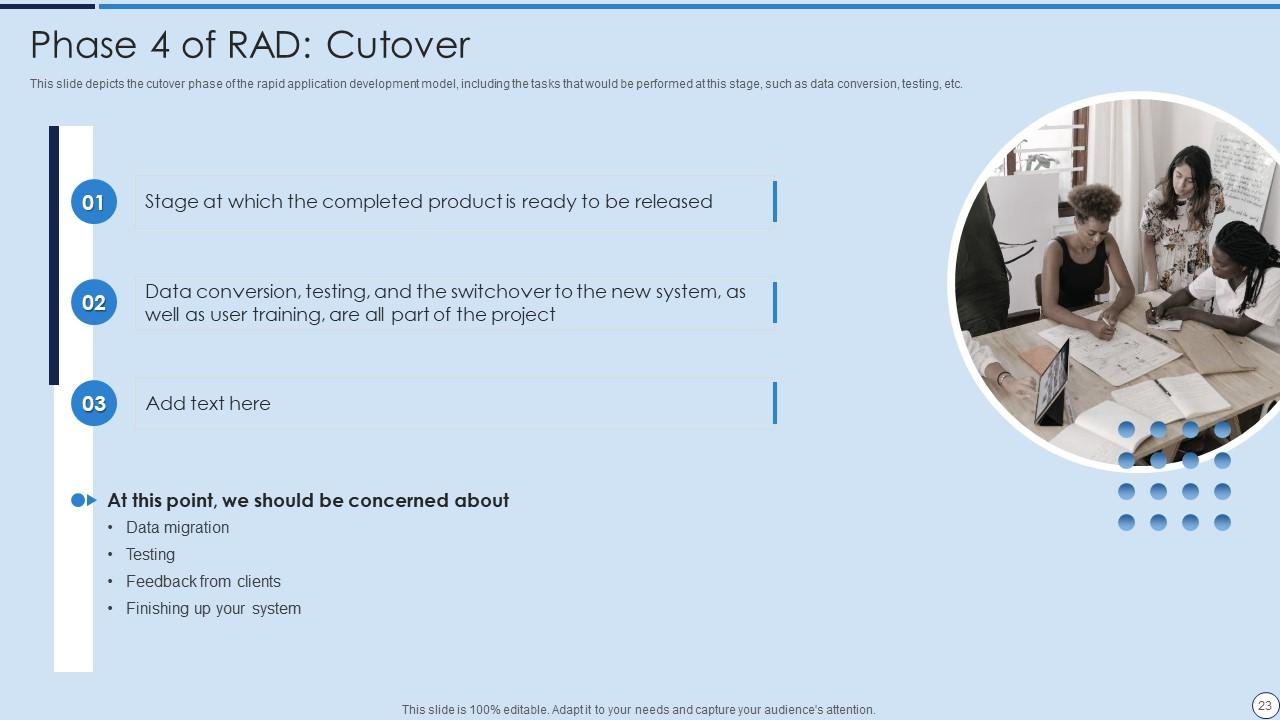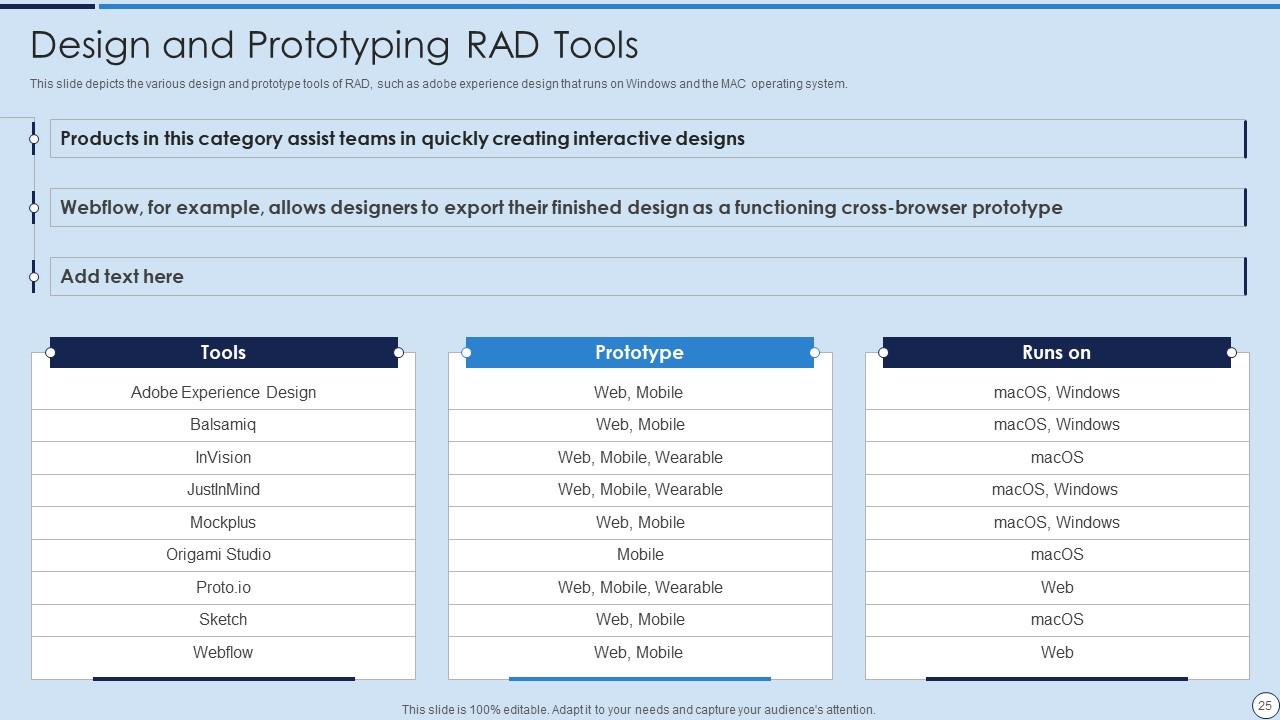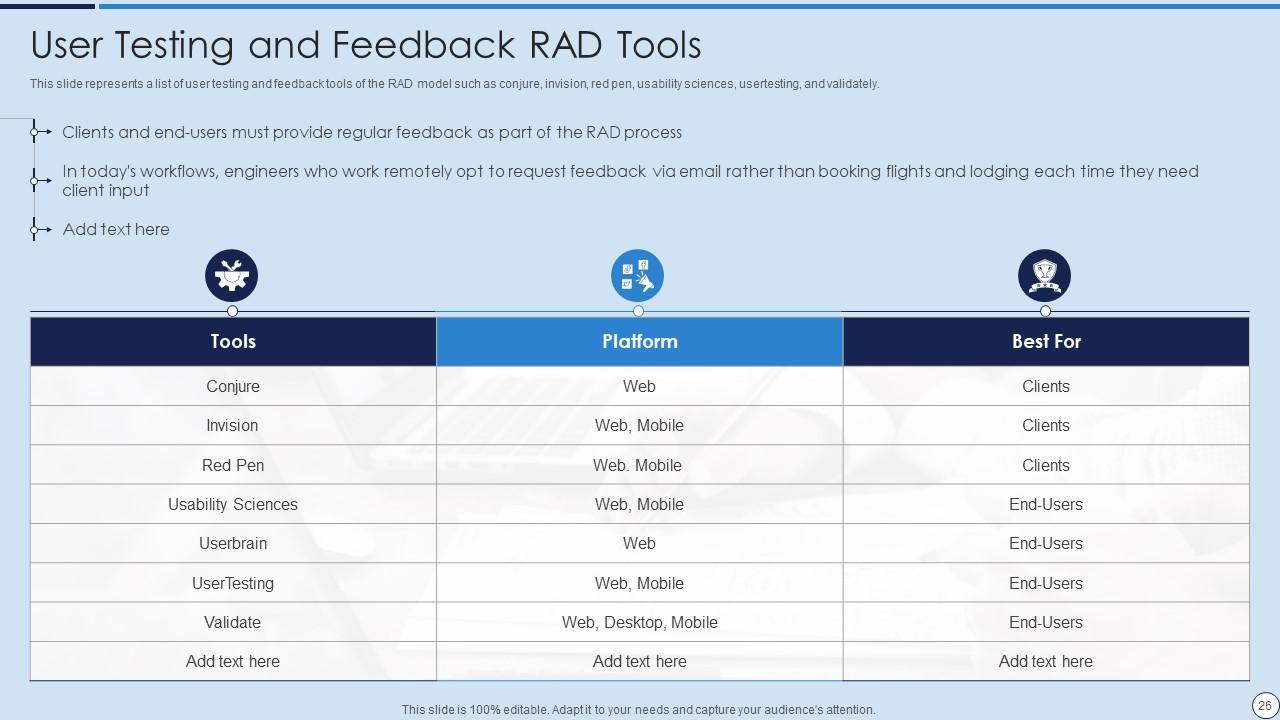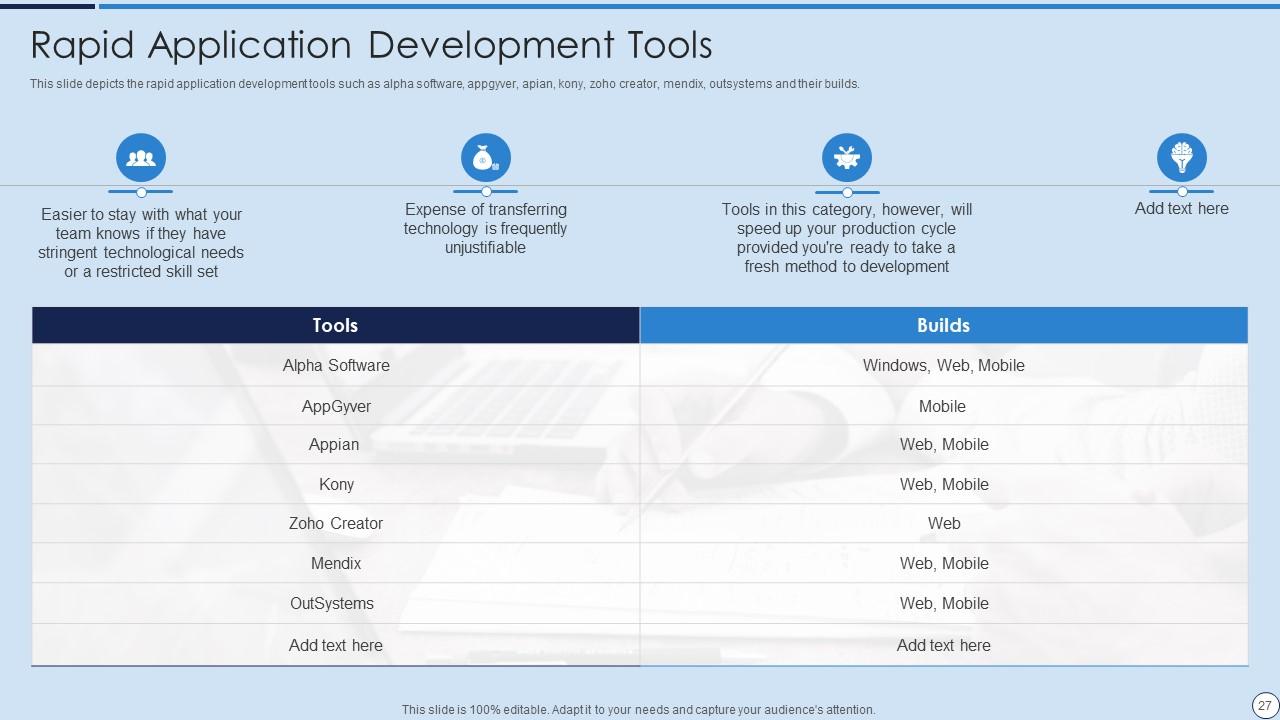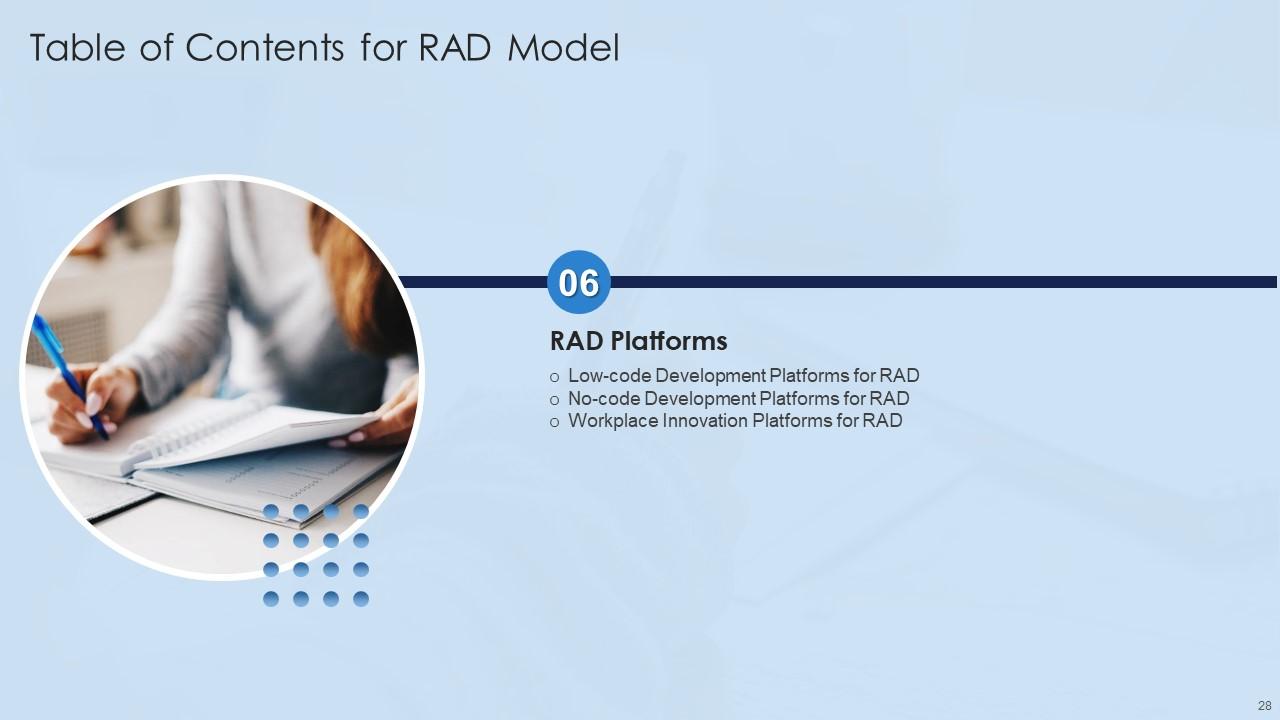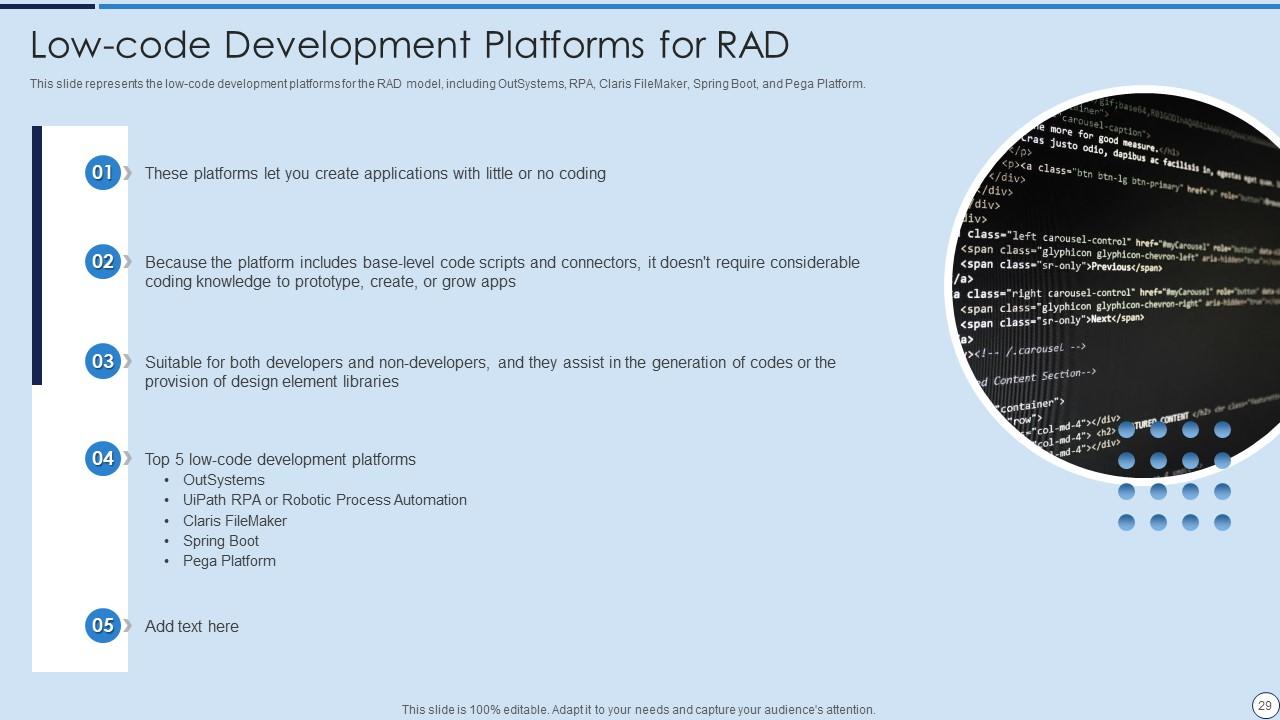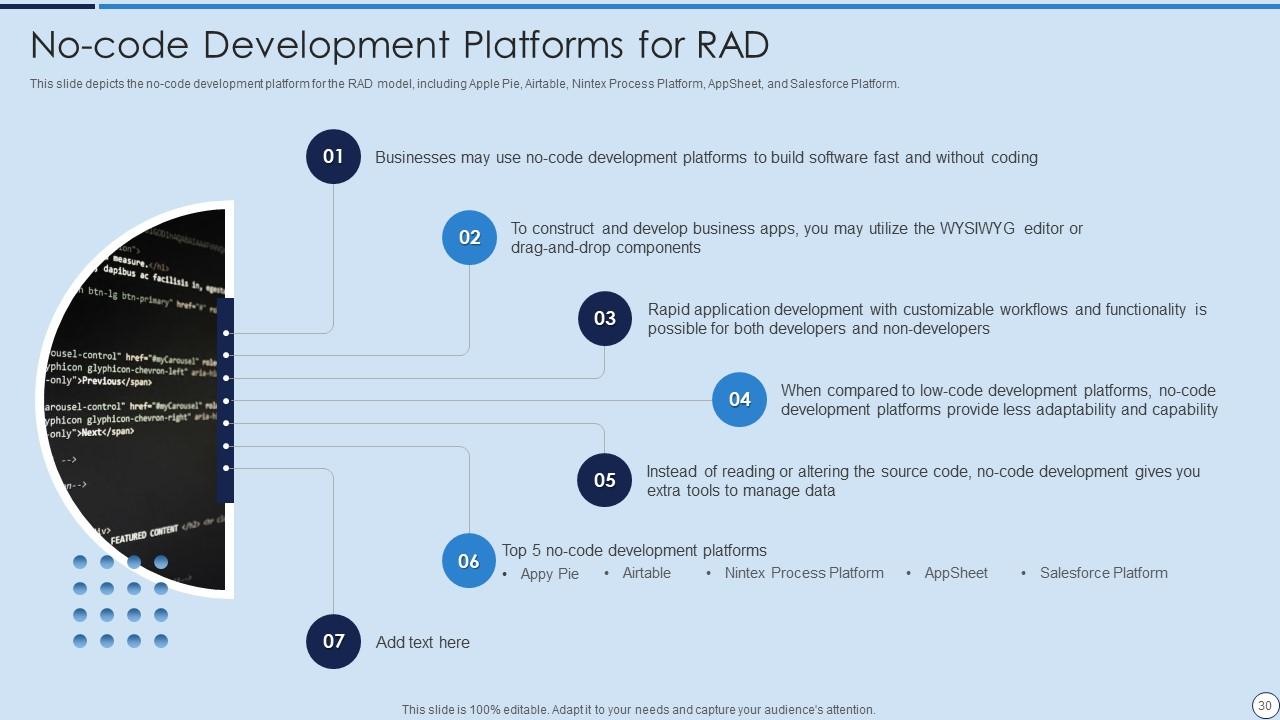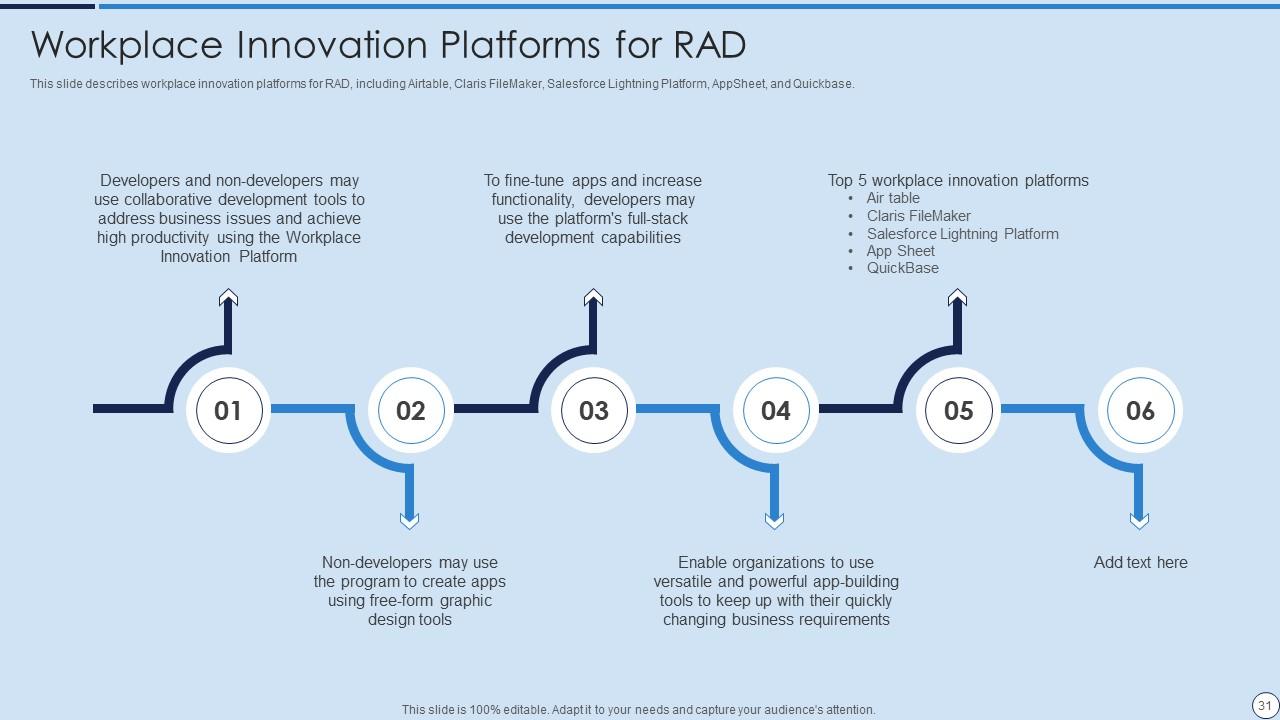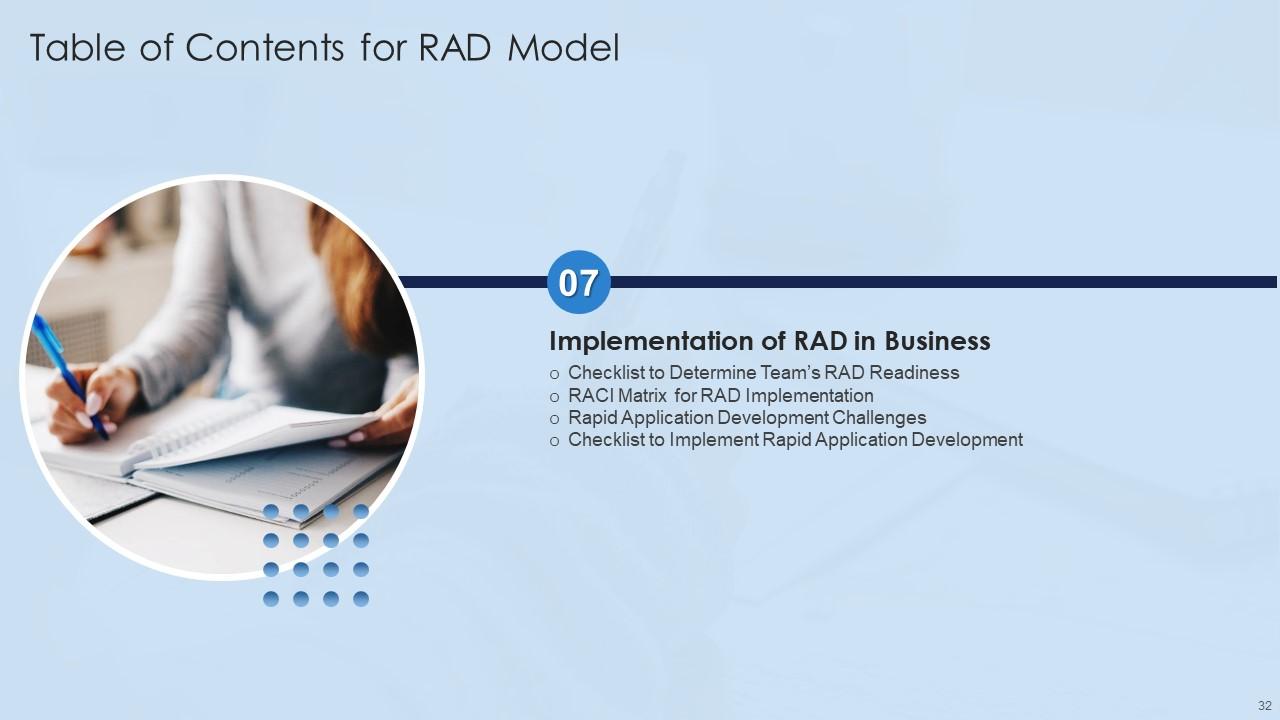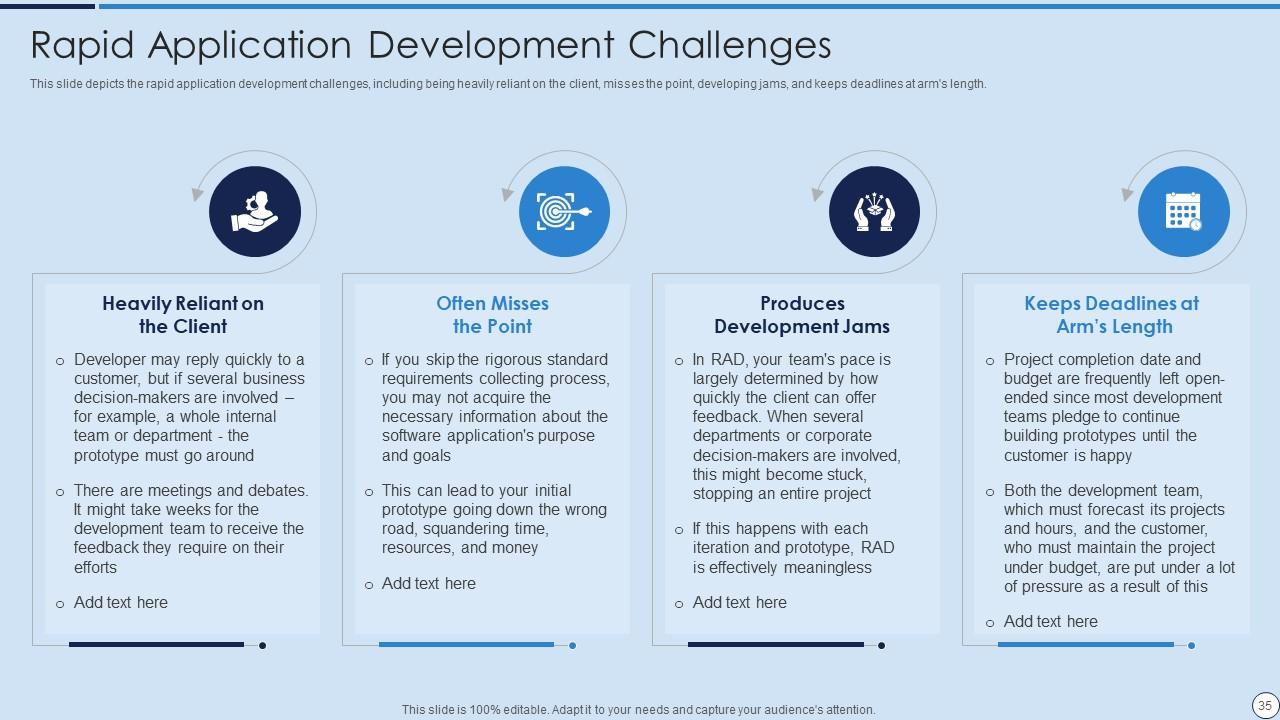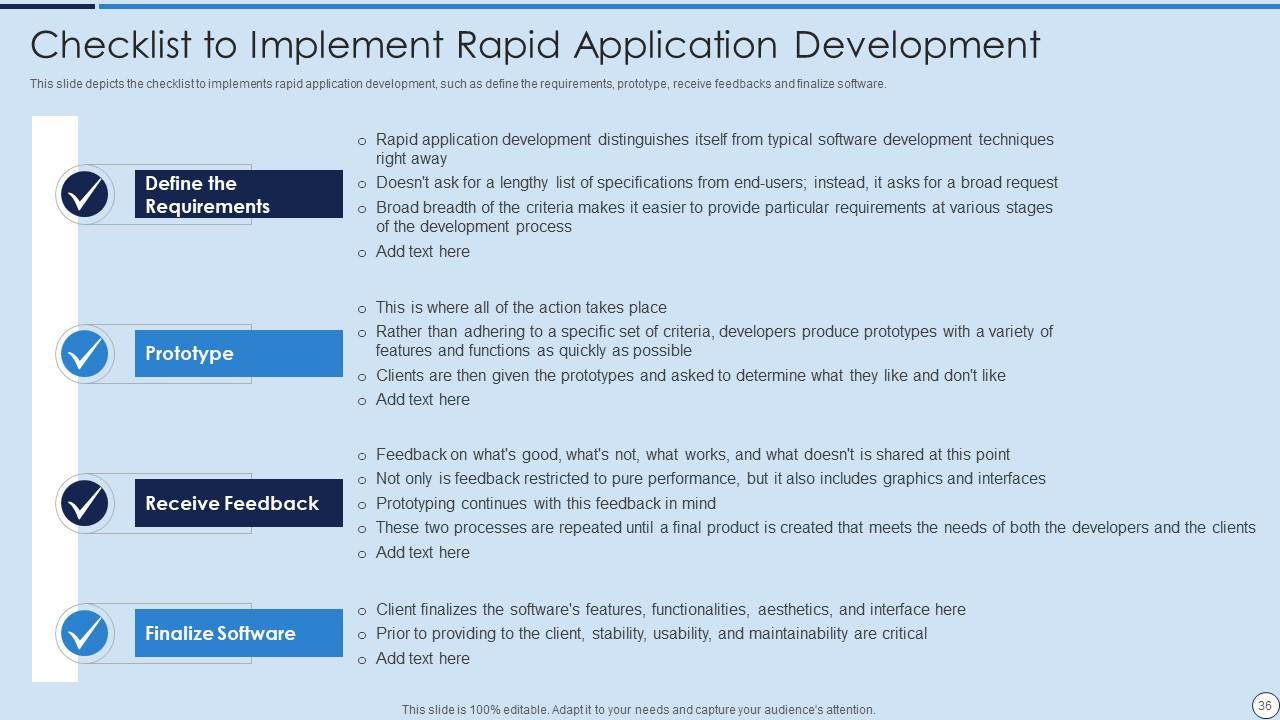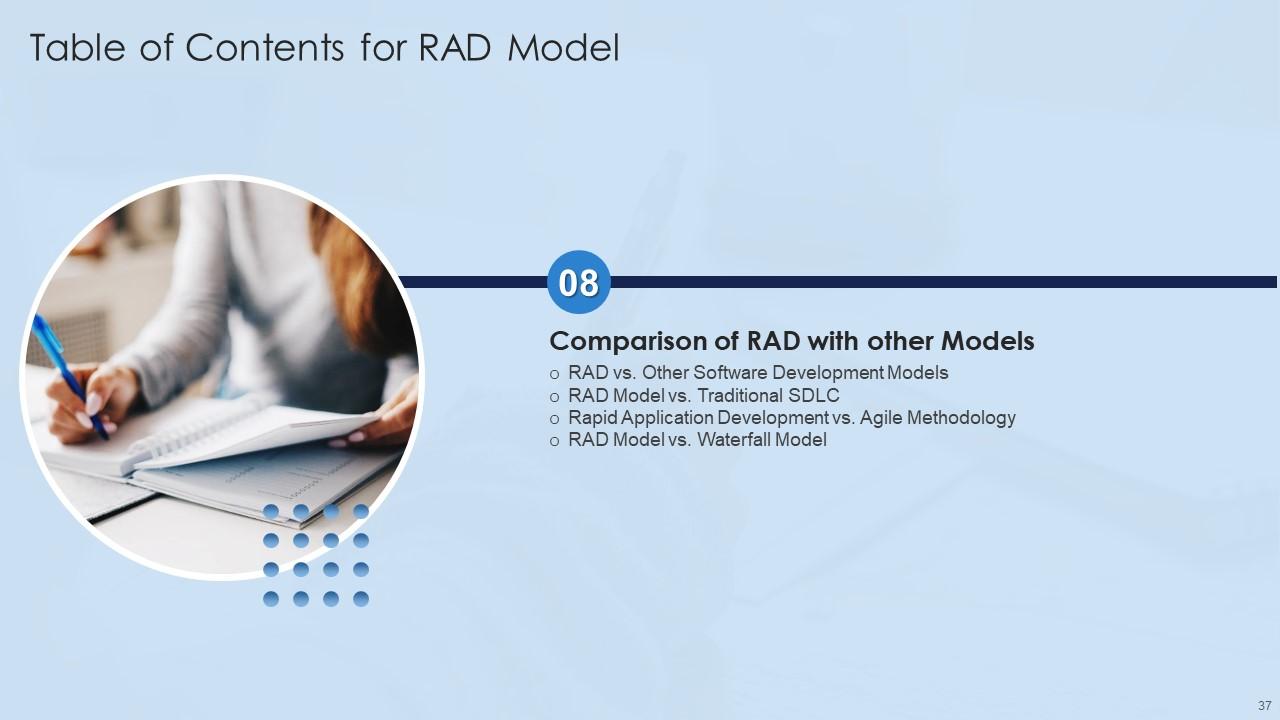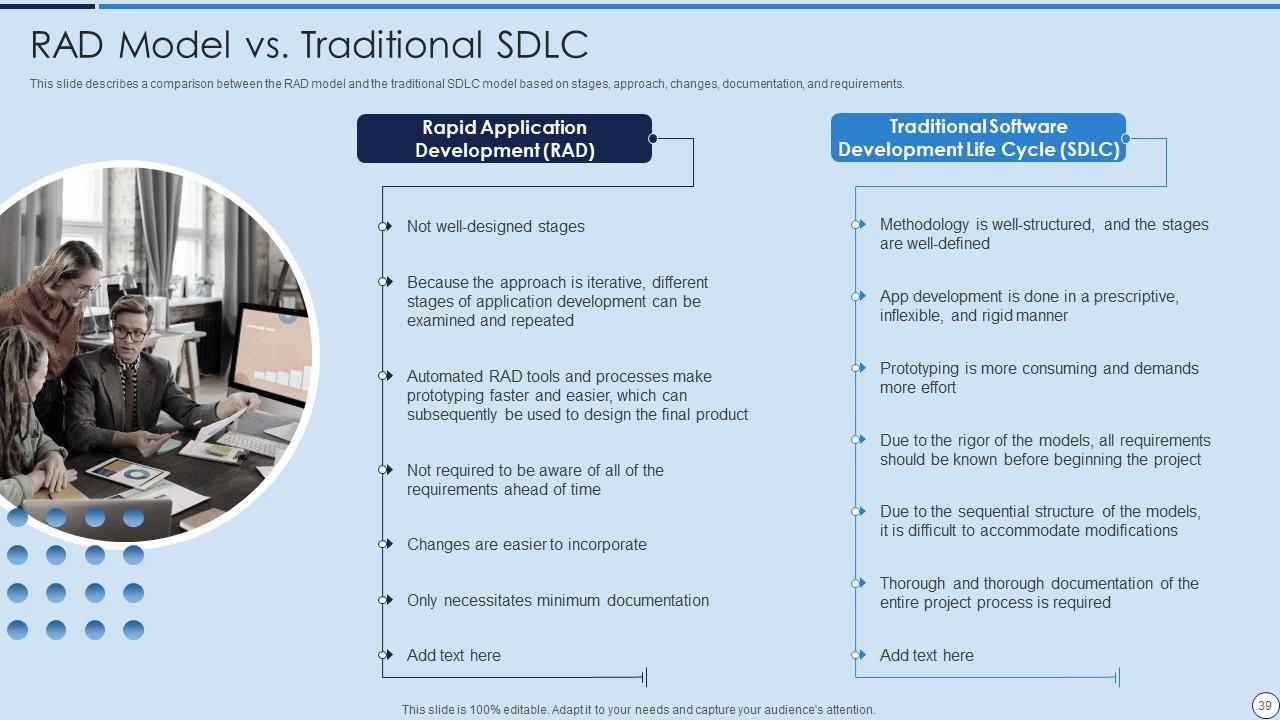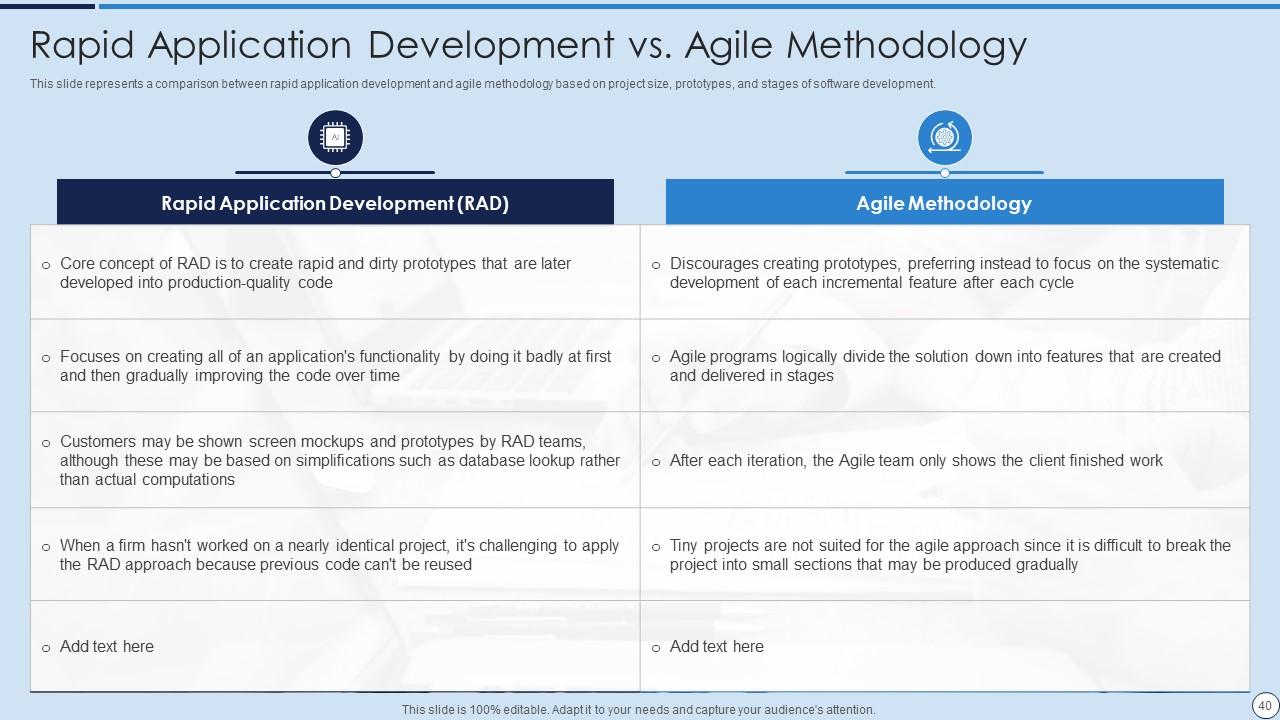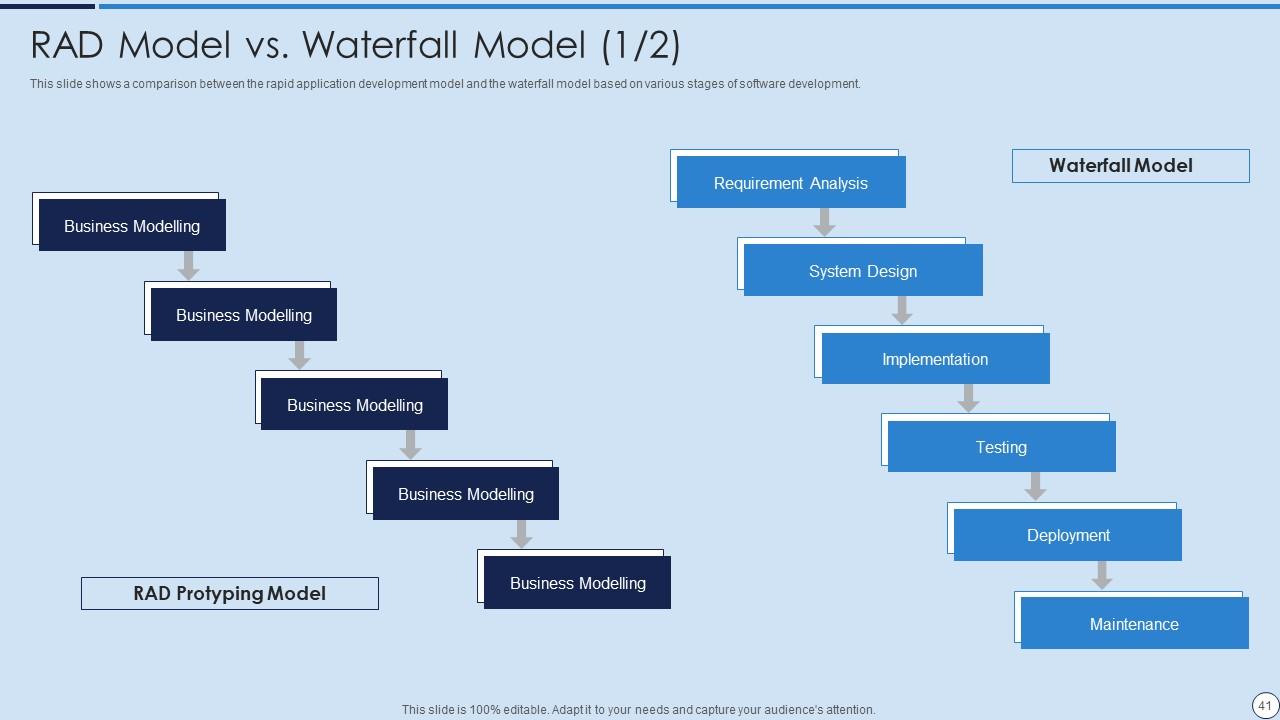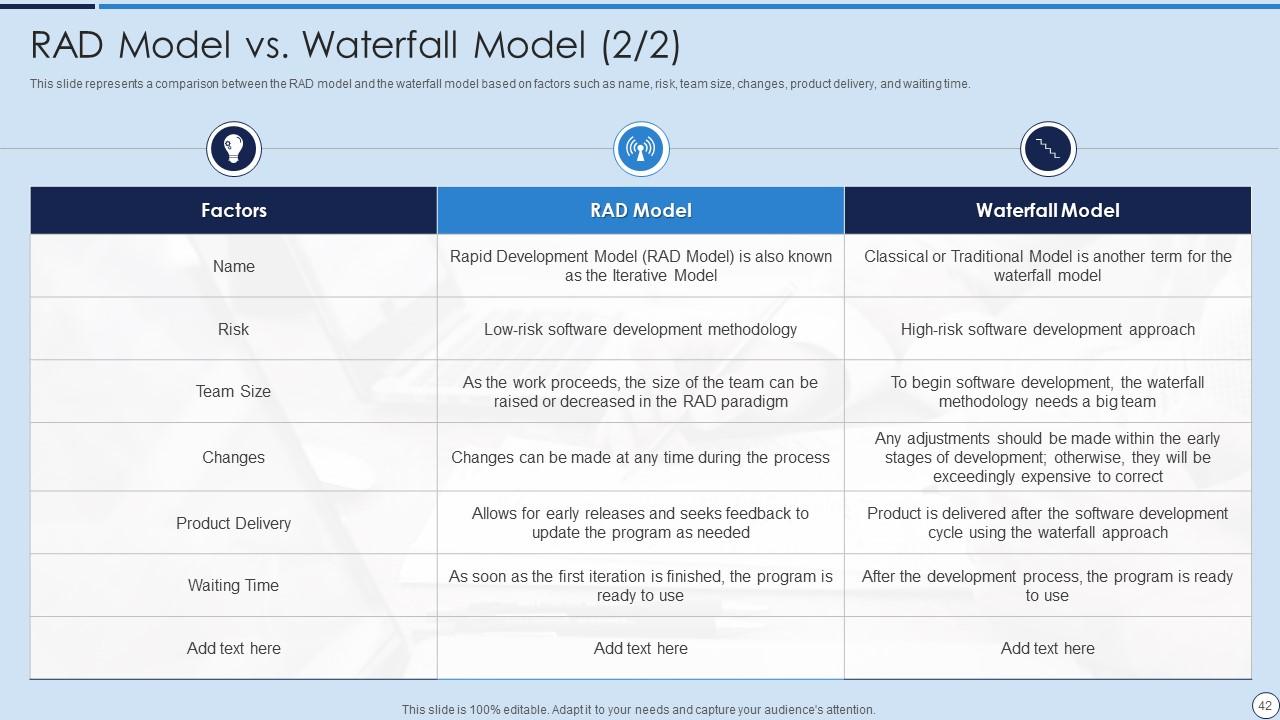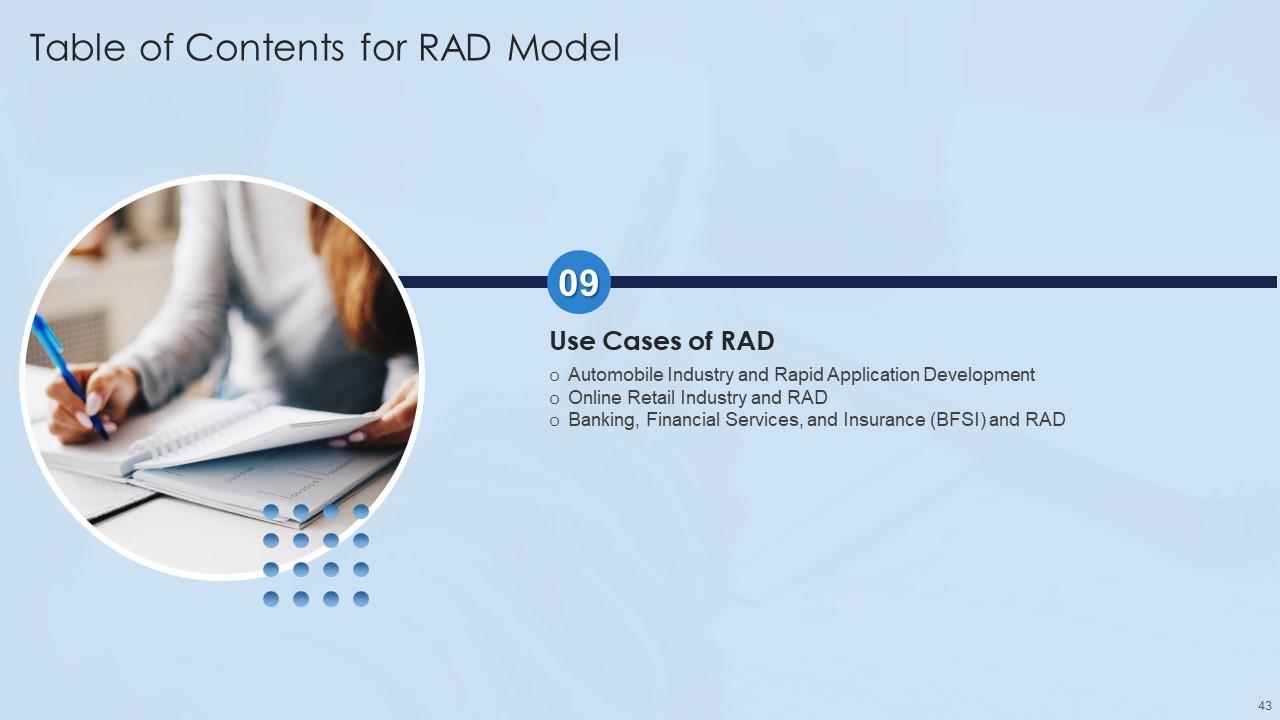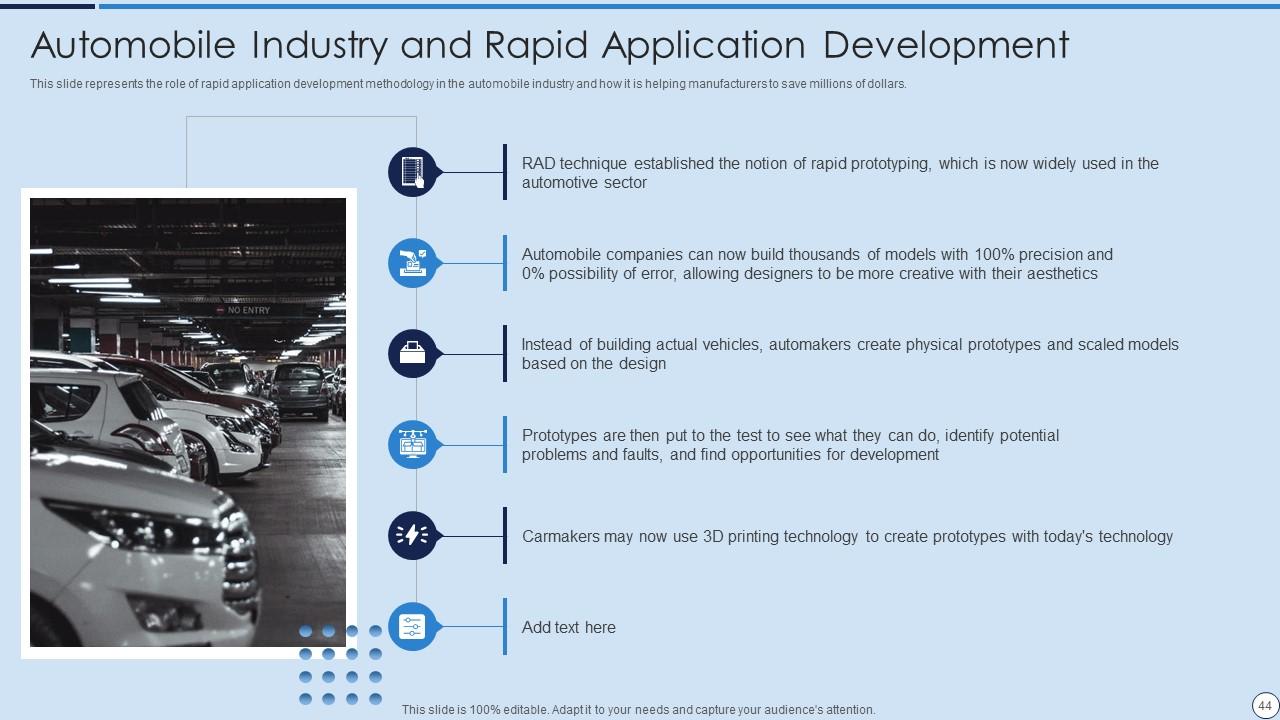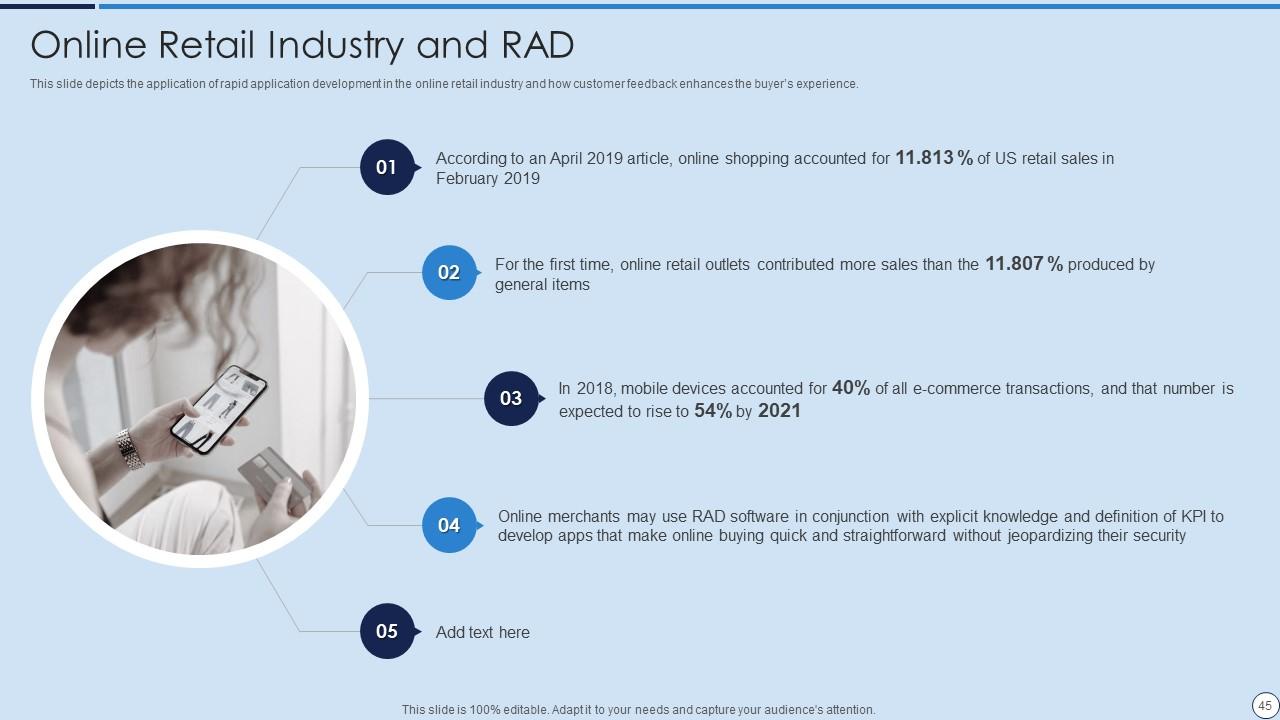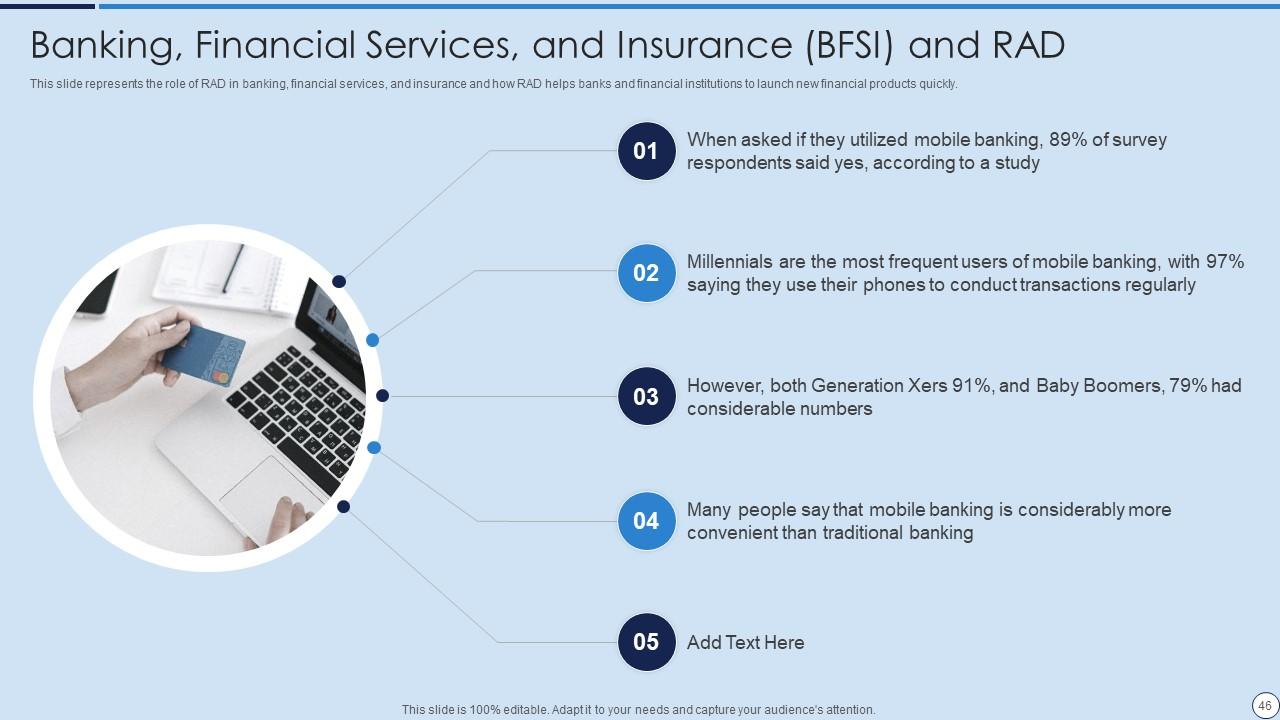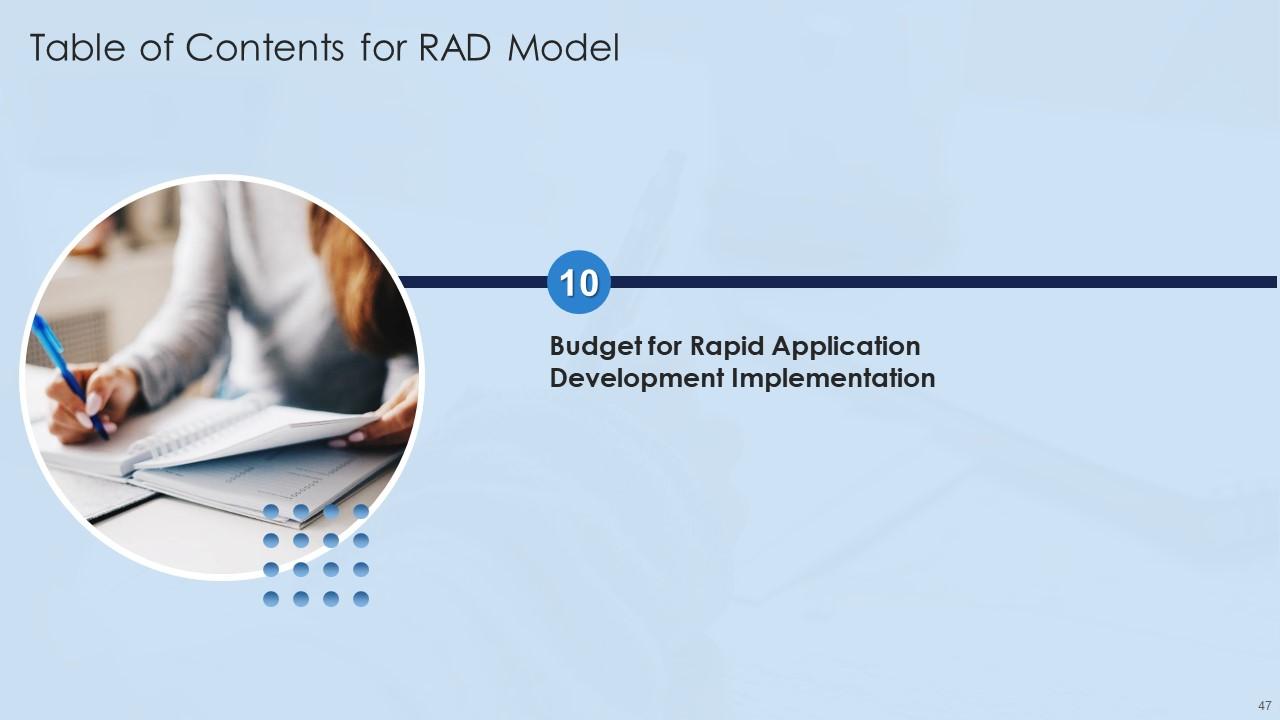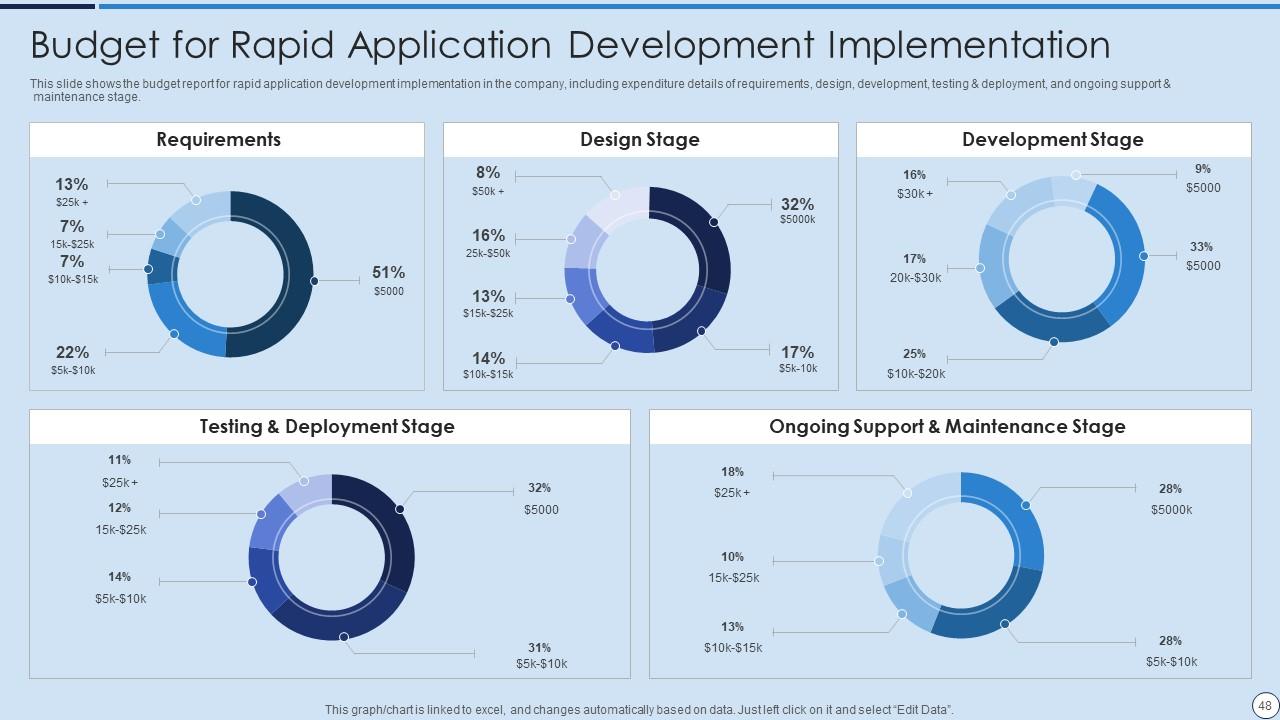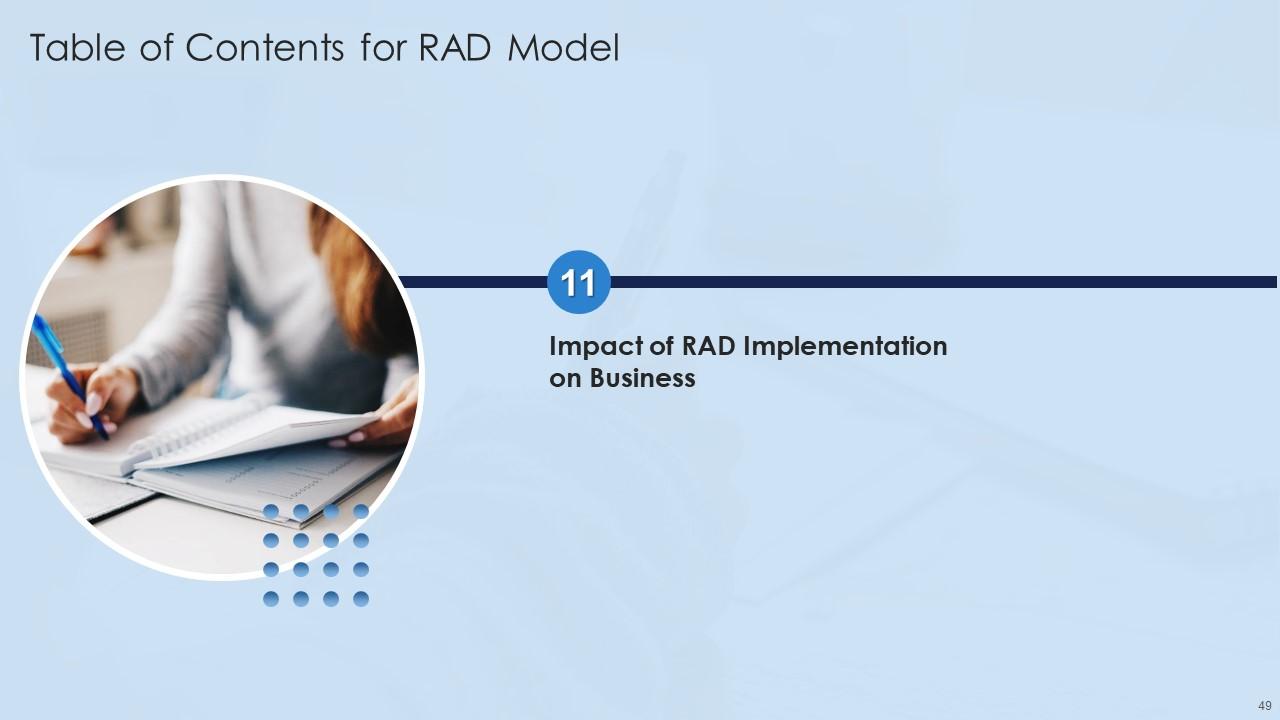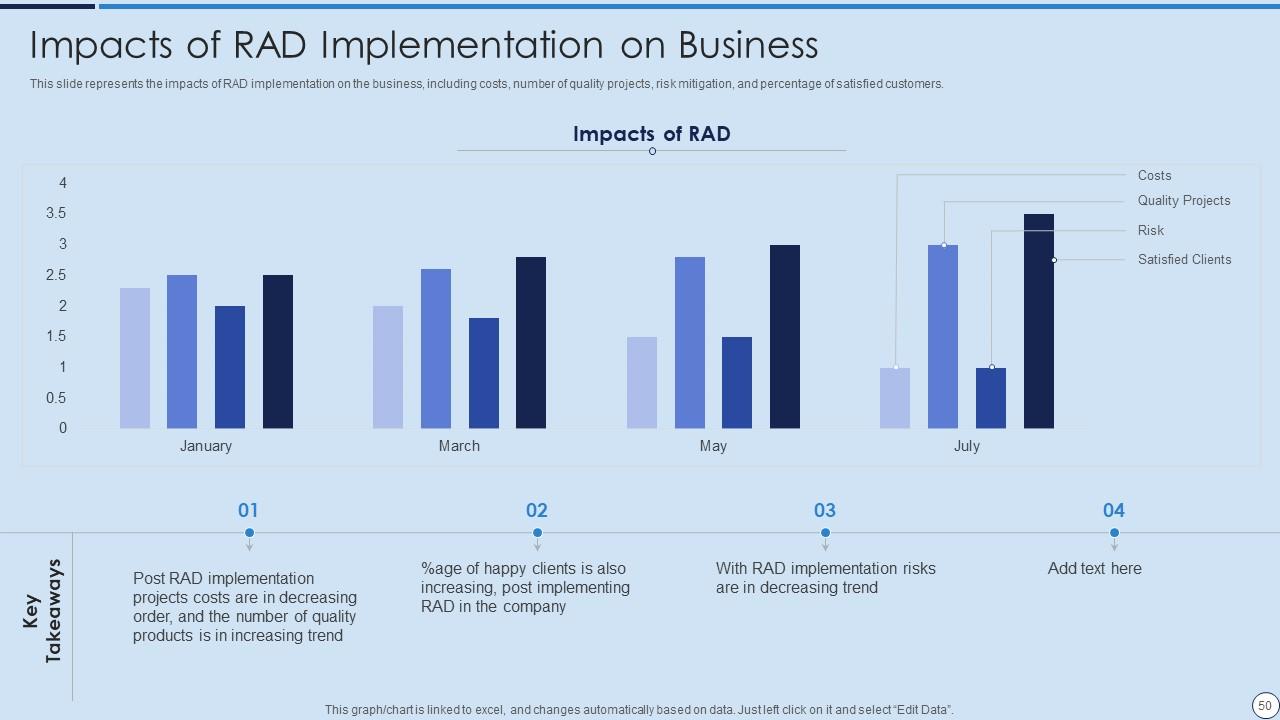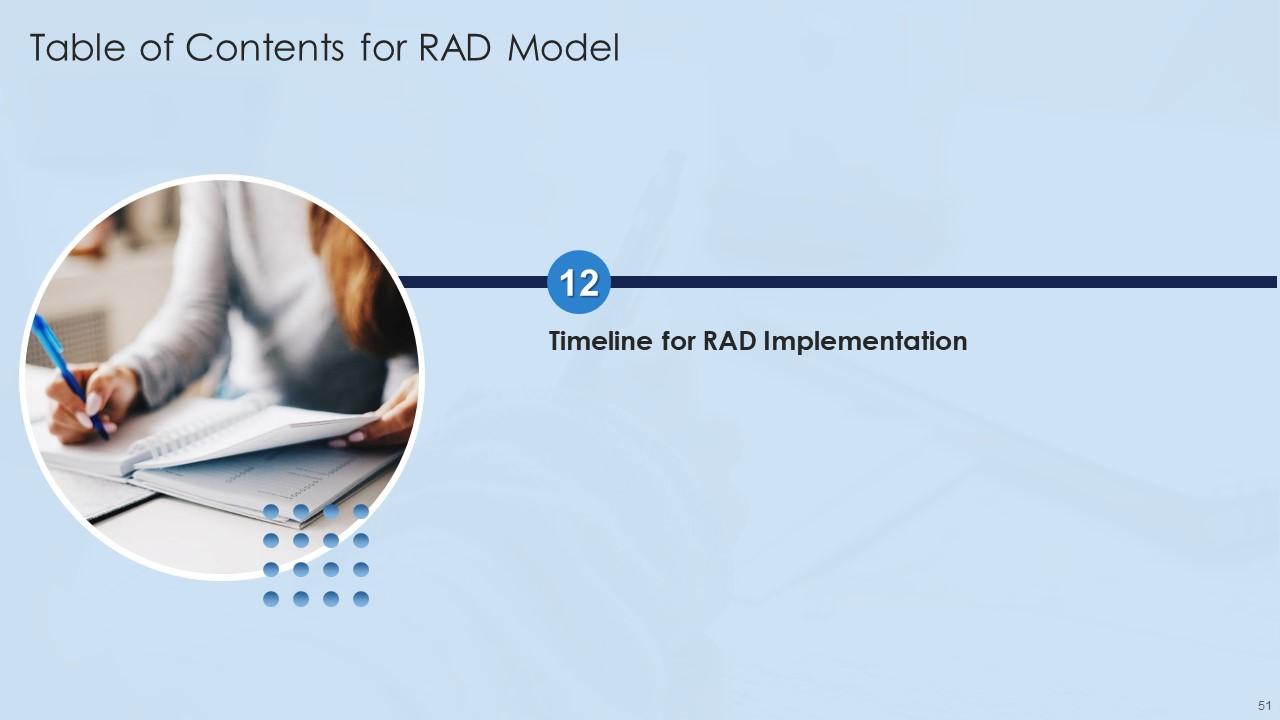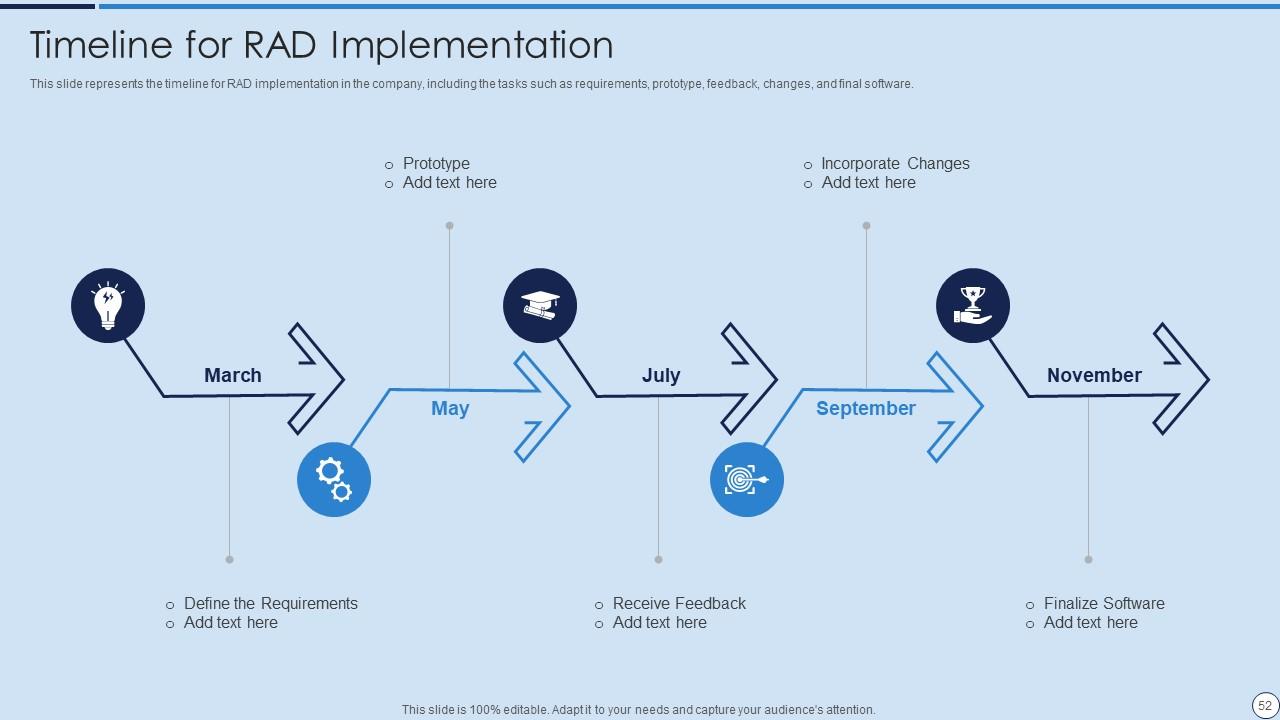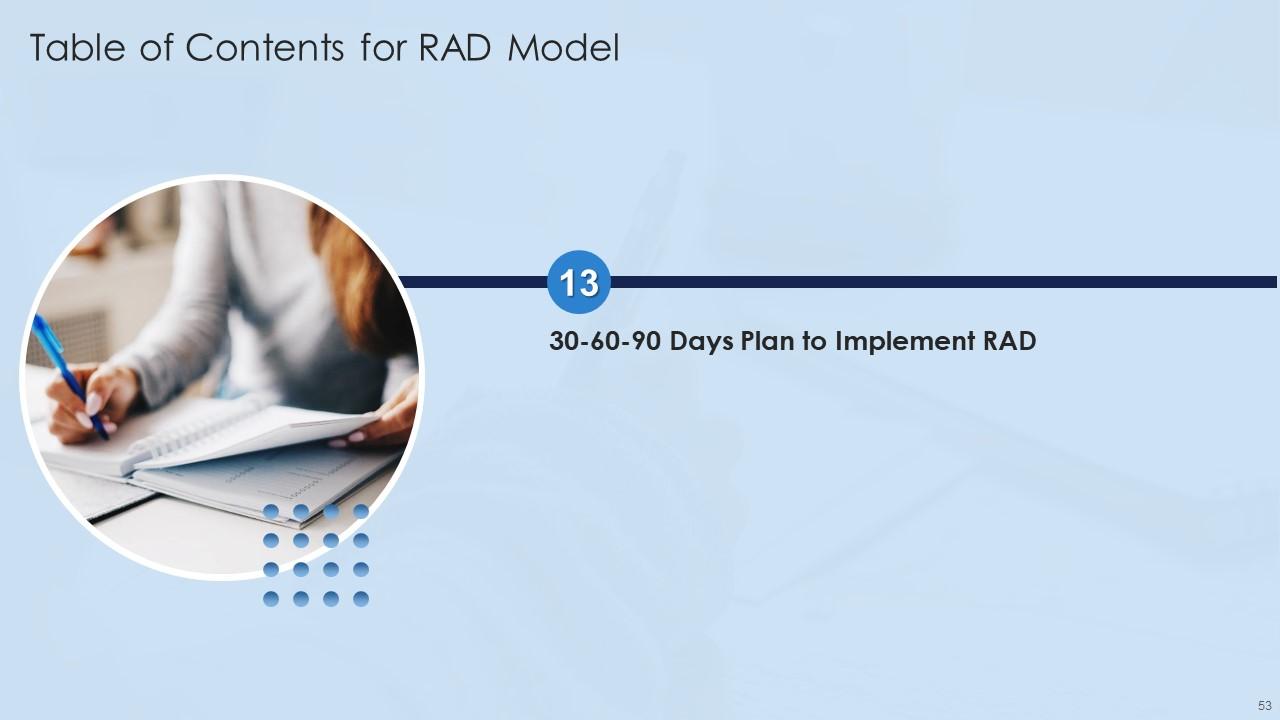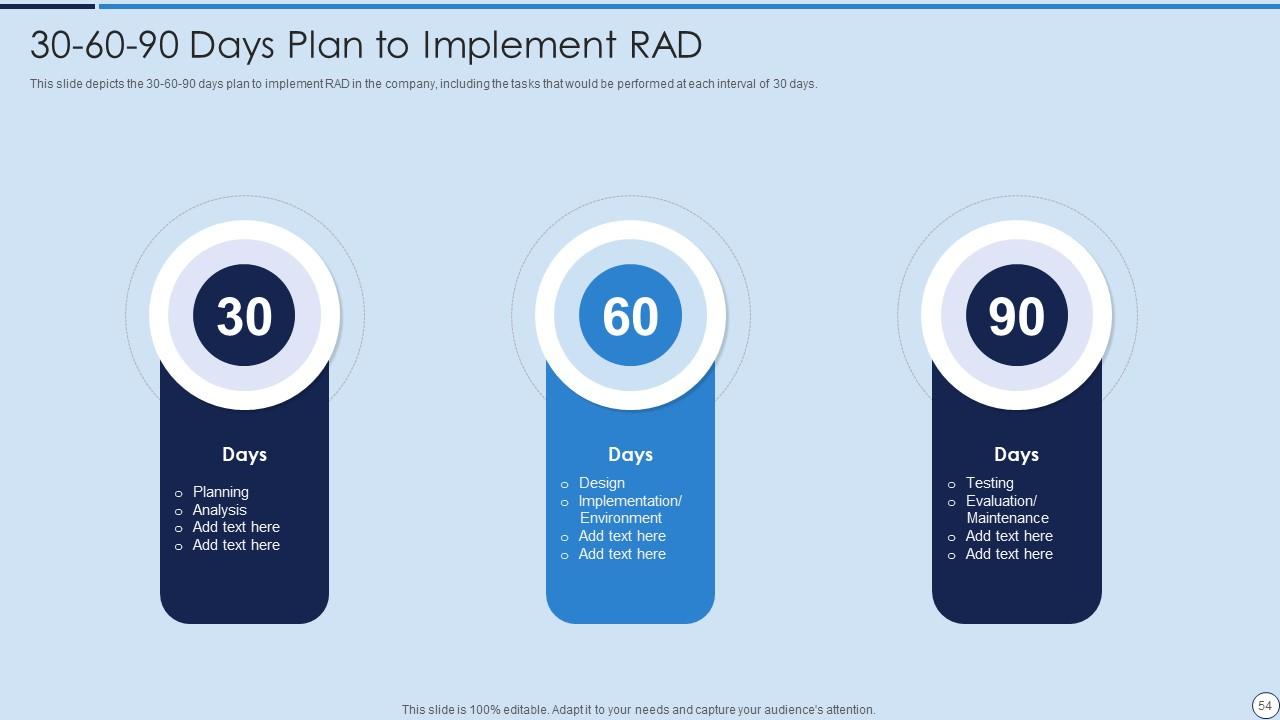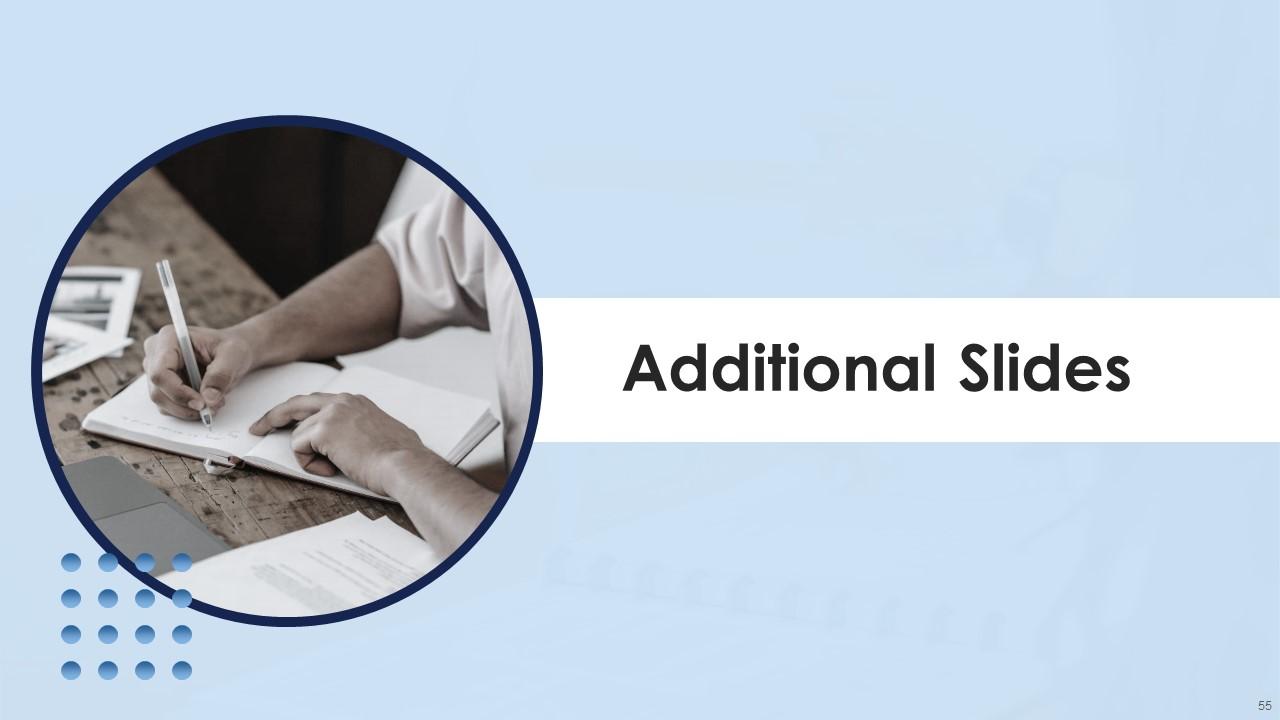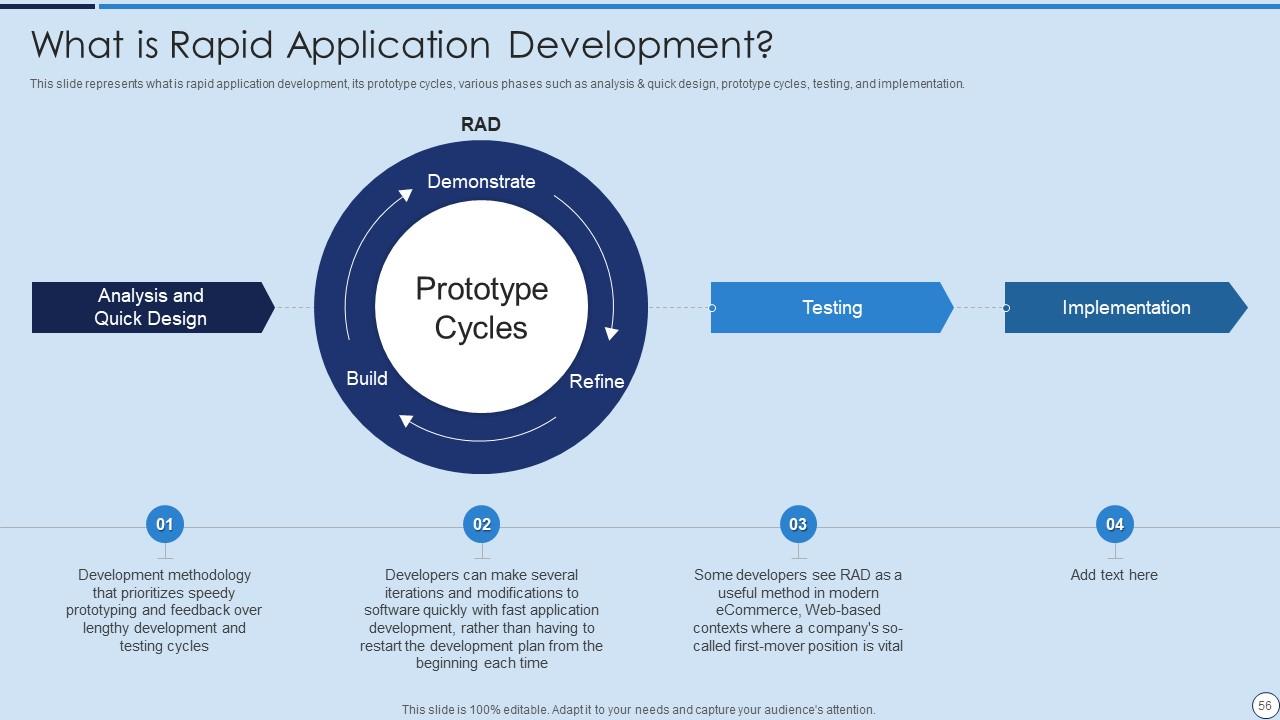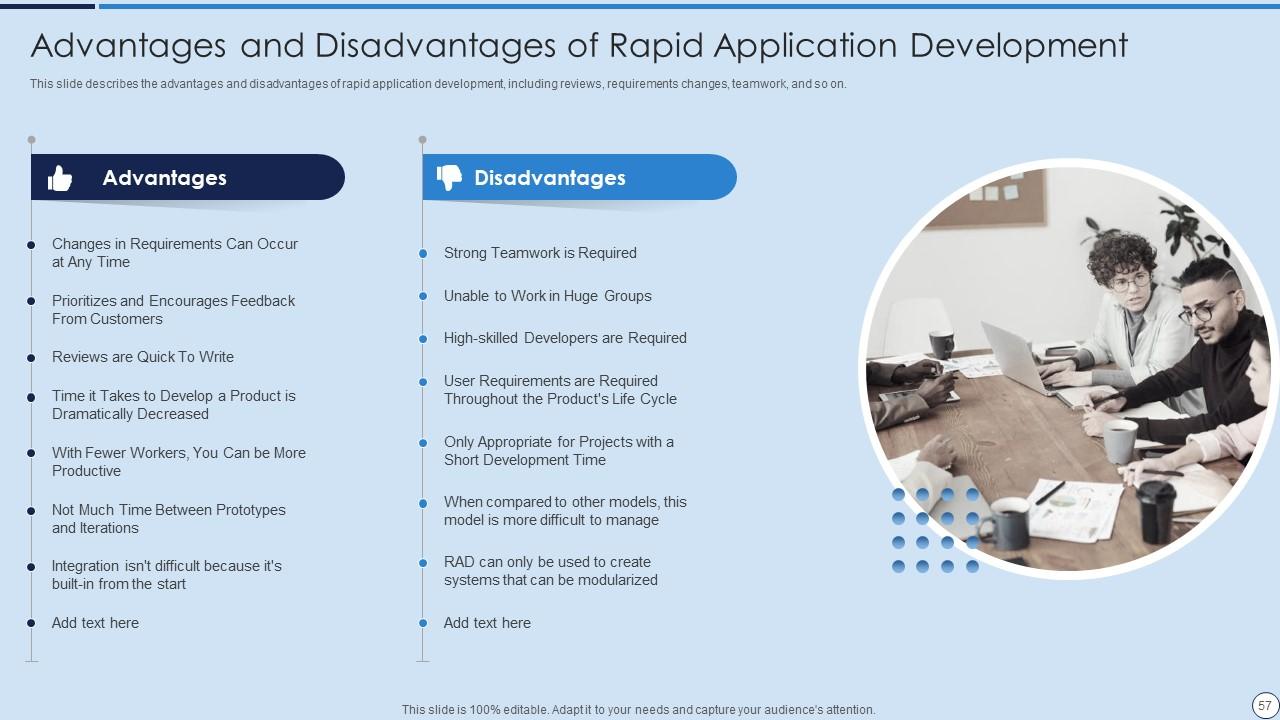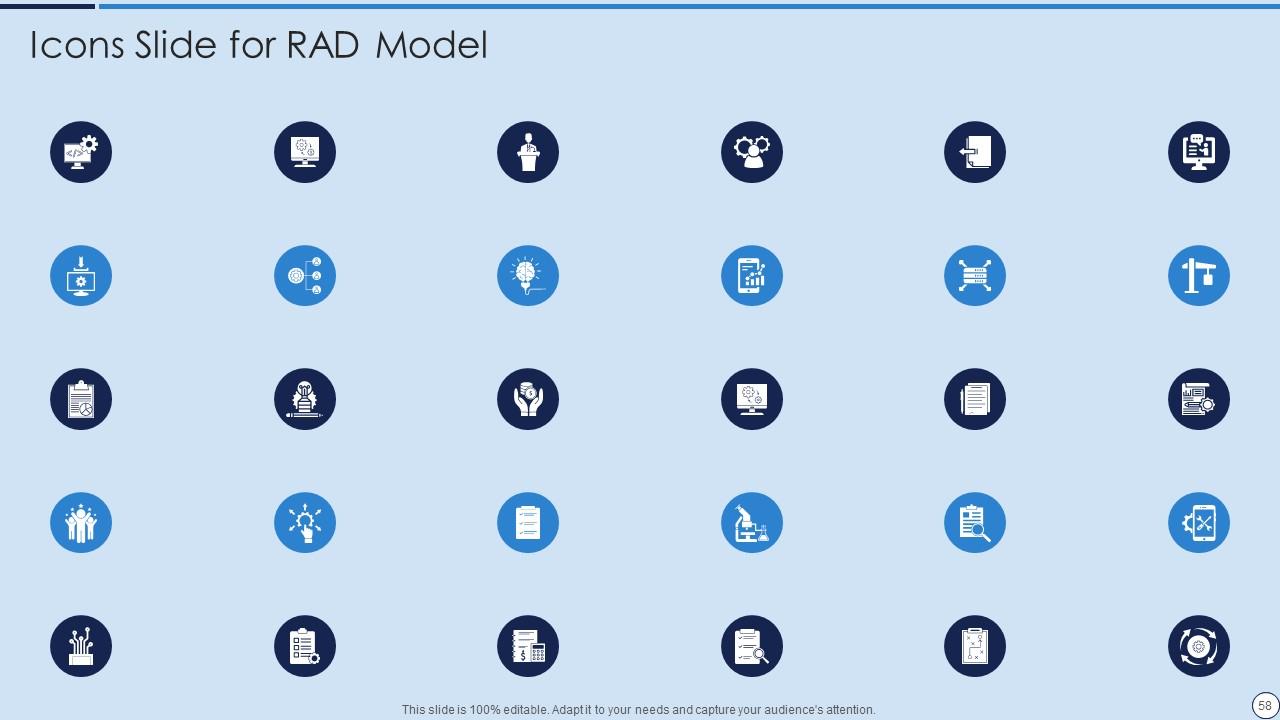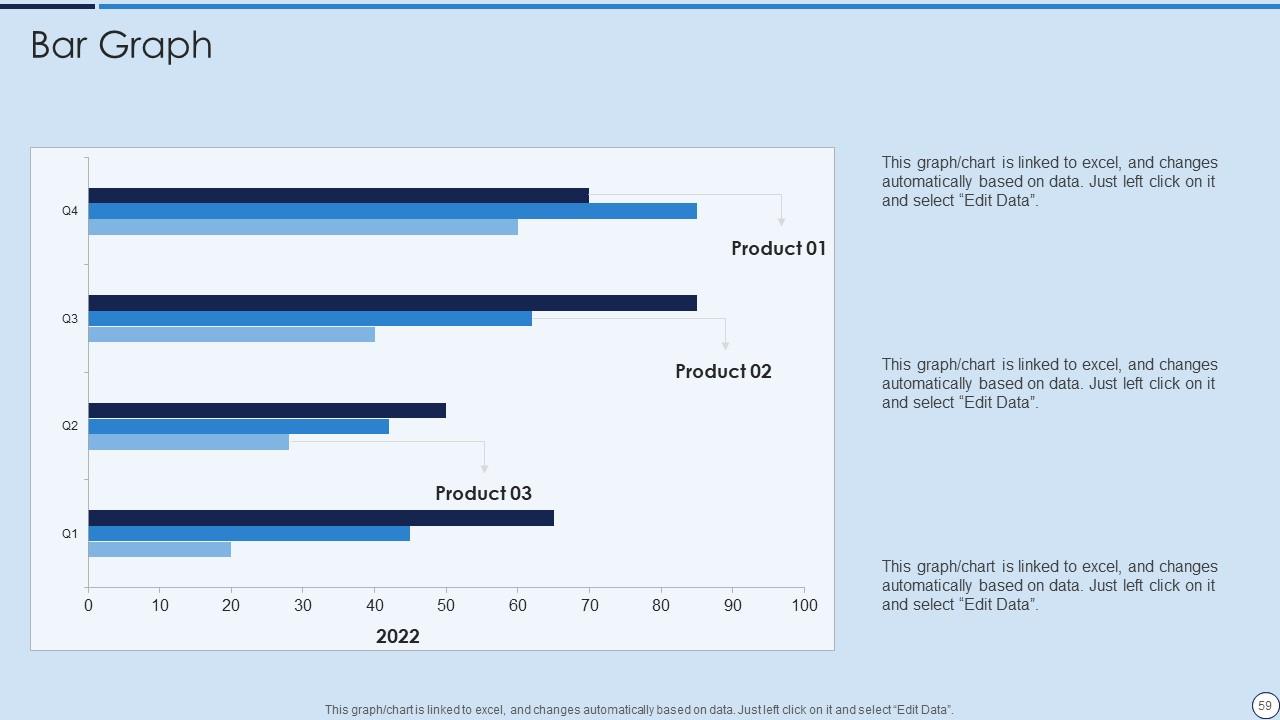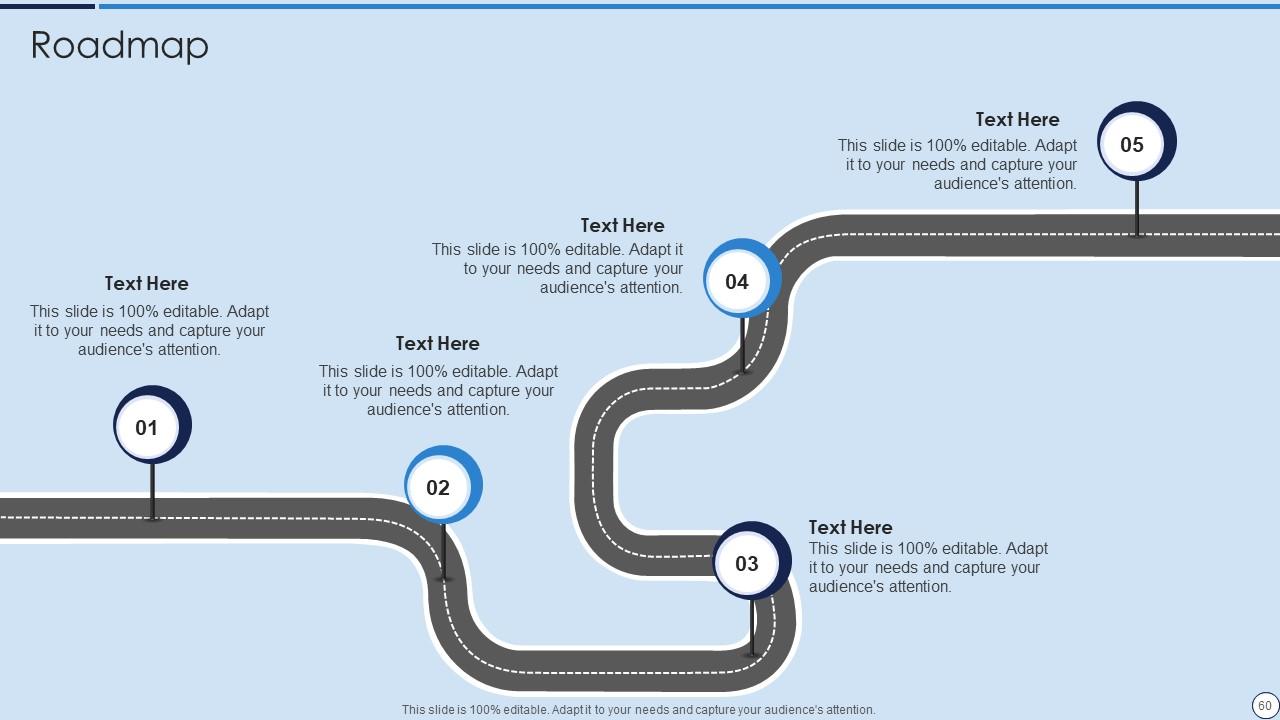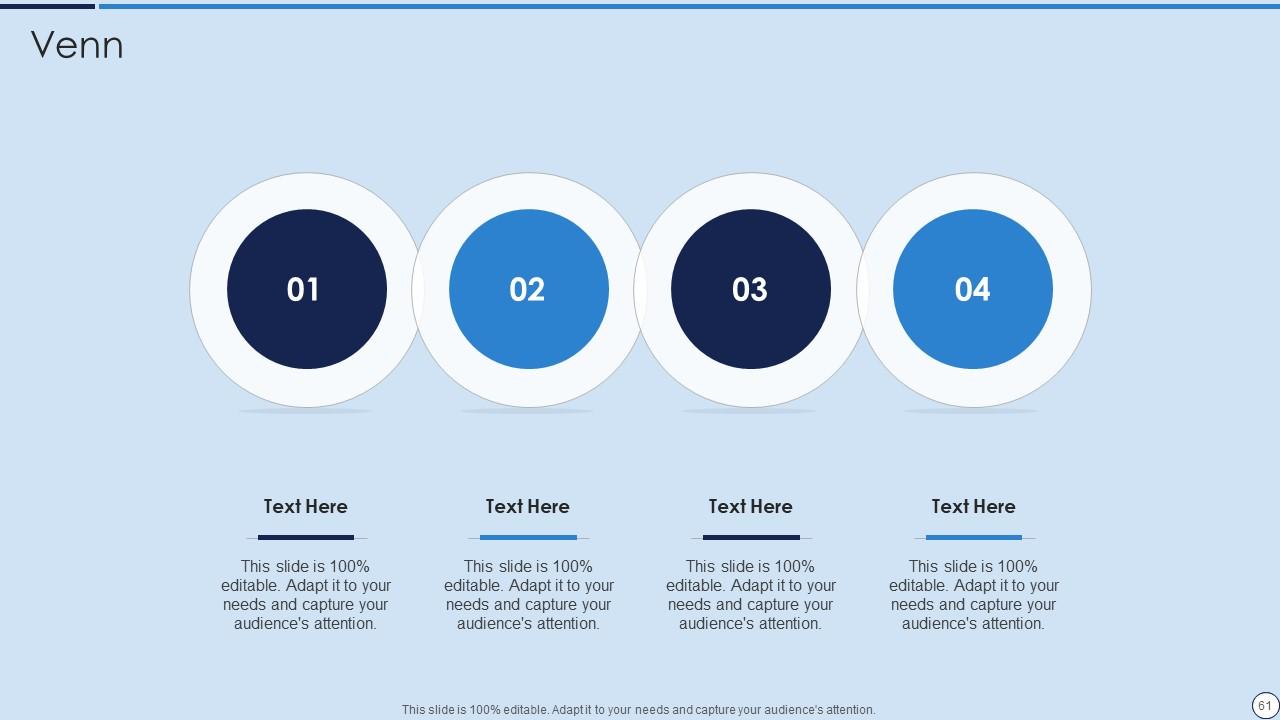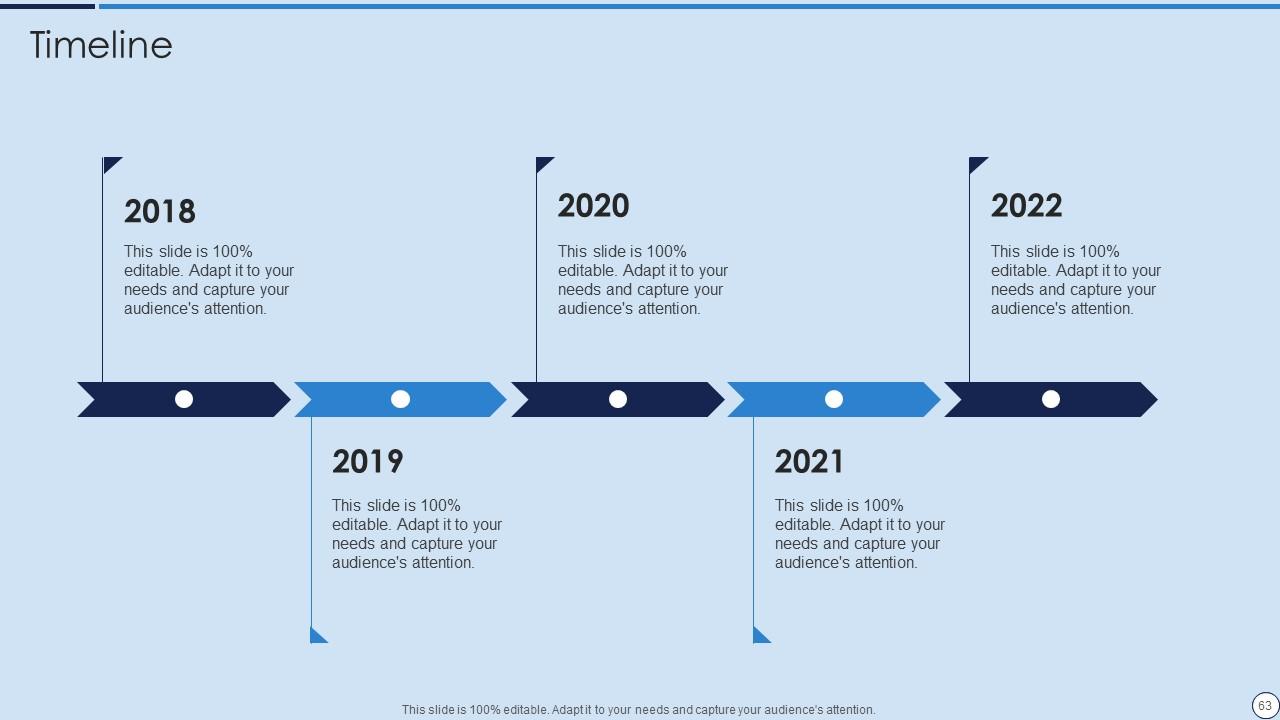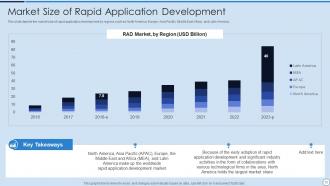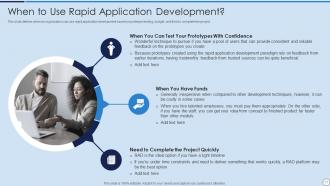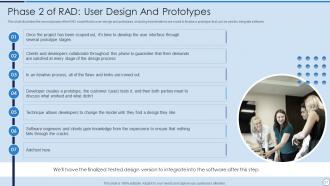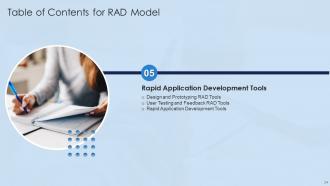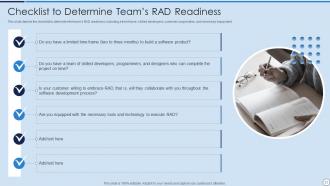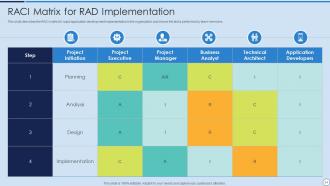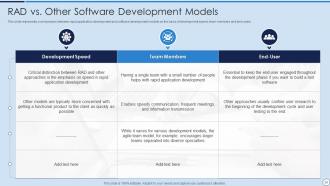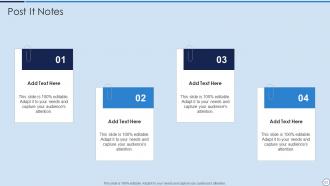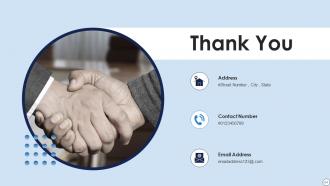RAD Model Powerpoint Presentation Slides
RAD model is an adaptive software development technique in which a software model is immediately modified based on user feedback. Grab our professionally designed RAD Model template that gives a brief idea about current problems faced by the company. In this PowerPoint Presentation, we have covered the need for the RAD model by showcasing details of its business benefits and market size. It also talks about the right time for implementing the RAD model in the company. In addition, this RAD Methodology PPT contains the RAD model, usage process, life-cycle, and the architecture of RAD methodology. Also, the presentation includes standard phases of the RAD model, such as requirement planning, user design and prototypes, rapid construction, and cutover. Moreover, it contains different RAD tools, platforms, and how to implement RAD in the company. Furthermore, this template compares the RAD model with other models such as Agile, Waterfall, and traditional SDLC. In addition, it also caters to use cases of RAD and a budget to implement RAD in the organization. Lastly, this RAD Methodology deck comprises impacts of RAD implementation on business, a timeline, etc. Get access now.
- Google Slides is a new FREE Presentation software from Google.
- All our content is 100% compatible with Google Slides.
- Just download our designs, and upload them to Google Slides and they will work automatically.
- Amaze your audience with SlideTeam and Google Slides.
-
Want Changes to This PPT Slide? Check out our Presentation Design Services
- WideScreen Aspect ratio is becoming a very popular format. When you download this product, the downloaded ZIP will contain this product in both standard and widescreen format.
-

- Some older products that we have may only be in standard format, but they can easily be converted to widescreen.
- To do this, please open the SlideTeam product in Powerpoint, and go to
- Design ( On the top bar) -> Page Setup -> and select "On-screen Show (16:9)” in the drop down for "Slides Sized for".
- The slide or theme will change to widescreen, and all graphics will adjust automatically. You can similarly convert our content to any other desired screen aspect ratio.
Compatible With Google Slides

Get This In WideScreen
You must be logged in to download this presentation.
PowerPoint presentation slides
Deliver an informational PPT on various topics by using this RAD Model Powerpoint Presentation Slides. This deck focuses and implements best industry practices, thus providing a birds-eye view of the topic. Encompassed with sixty four slides, designed using high-quality visuals and graphics, this deck is a complete package to use and download. All the slides offered in this deck are subjective to innumerable alterations, thus making you a pro at delivering and educating. You can modify the color of the graphics, background, or anything else as per your needs and requirements. It suits every business vertical because of its adaptable layout.
People who downloaded this PowerPoint presentation also viewed the following :
Content of this Powerpoint Presentation
Slide 1: This slide displays title i.e. 'RAD Model' and your Company Name.
Slide 2: This slide presents agenda.
Slide 3: This slide exhibits table of contents.
Slide 4: This slide also shows table of contents.
Slide 5: This slide depicts title for one topic that is to be covered next in the template.
Slide 6: This slide depicts the problem faced by a company that is spending a lot of time on planning and iteration and is not able to deliver the projects on time.
Slide 7: This slide depicts title for four topics that are to be covered next in the template.
Slide 8: This slide represents the reasons that why we should choose the rapid application development model, including its flexibility to changes, etc.
Slide 9: This slide shows the business benefits of the rapid application development methodology such as enhanced quality & usability, etc.
Slide 10: This slide depicts the market size of rapid application development by regions such as North America, Europe, Asia Pacific, etc.
Slide 11: This slide defines when an organization can use rapid application development based on prototype testing, budget, and time to complete the project.
Slide 12: This slide depicts title for three topics that are to be covered next in the template.
Slide 13: This slide depicts the rapid application development model in detail consisting of business modeling, data modeling, process modeling, etc.
Slide 14: This slide represents the rapid application development model design, including business modeling, information modeling, process modeling, etc.
Slide 15: This slide represents the rapid application development life-cycle, including planning, analysis, design, implementation, testing, etc.
Slide 16: This slide depicts title for seven topics that are to be covered next in the template.
Slide 17: This slide represents the architecture of rapid application development that consists of backend systems, logic apps, etc.
Slide 18: This slide represents the rapid application development architecture that is consists of user interface components, mobile extensions, etc.
Slide 19: This slide represents the four phases of rapid application development methodology, including requirement planning, prototype cycle, etc.
Slide 20: This slide depicts the requirement planning phase of the rapid application development model, including the tasks that would be performed in this stage.
Slide 21: This slide illustrates the second phase of the RAD model that is user-design and prototypes.
Slide 22: This slide represents the third phase of the rapid application development model that is rapid construction, including how programmers, coders, etc.
Slide 23: This slide depicts the cutover phase of the rapid application development model, including the tasks that would be performed at this stage.
Slide 24: This slide depicts title for three topics that are to be covered next in the template.
Slide 25: This slide depicts the various design and prototype tools of RAD, such as adobe experience design that runs on Windows and the MAC operating system.
Slide 26: This slide represents a list of user testing and feedback tools of the RAD model such as conjure, invision, red pen, usability sciences, etc.
Slide 27: This slide depicts the rapid application development tools such as alpha software, appgyver, apian, kony, zoho creator, mendix, etc.
Slide 28: This slide depicts title for three topics that are to be covered next in the template.
Slide 29: This slide represents the low-code development platforms for the RAD model, including OutSystems, RPA, Claris FileMaker, Spring Boot, and Pega Platform.
Slide 30: This slide depicts the no-code development platform for the RAD model, including Apple Pie, Airtable, Nintex Process Platform, etc.
Slide 31: This slide describes workplace innovation platforms for RAD, including Airtable, Claris FileMaker, Salesforce Lightning Platform, AppSheet, etc.
Slide 32: This slide depicts title for four topics that are to be covered next in the template.
Slide 33: This slide depicts the checklist to determine the team’s RAD readiness, including a time frame, skilled developers, customer cooperation, etc.
Slide 34: This slide describes the RACI matrix for rapid application development implementation in the organization and shows the tasks performed by team members.
Slide 35: This slide depicts the rapid application development challenges, including being heavily reliant on the client, misses the point, developing jams, etc.
Slide 36: This slide depicts the checklist to implements rapid application development.
Slide 37: This slide depicts title for five topics that are to be covered next in the template.
Slide 38: This slide represents a comparison between rapid application development and software development models on the basis of development speed, etc.
Slide 39: This slide describes a comparison between the RAD model and the traditional SDLC model based on stages, approach, changes, documentation, and requirements.
Slide 40: This slide represents a comparison between rapid application development and agile methodology based on project size, prototypes, etc.
Slide 41: This slide shows a comparison between the rapid application development model and the waterfall model based on various stages of software development.
Slide 42: This slide represents a comparison between the RAD model and the waterfall model based on factors such as name, risk, team size, changes, etc.
Slide 43: This slide depicts title for three topics that are to be covered next in the template.
Slide 44: This slide represents the role of rapid application development methodology in the automobile industry.
Slide 45: This slide depicts the application of rapid application development in the online retail industry and how customer feedback enhances the buyer’s experience.
Slide 46: This slide represents the role of RAD in banking, financial services, and insurance and how RAD helps banks and financial institutions.
Slide 47: This slide depicts title for one topic that is to be covered next in the template.
Slide 48: This slide shows the budget report for rapid application development implementation in the company, including expenditure details of requirements, etc.
Slide 49: This slide depicts title for one topic that is to be covered next in the template.
Slide 50: This slide represents the impacts of RAD implementation on the business, including costs, number of quality projects, risk mitigation, etc.
Slide 51: This slide depicts title for one topic that is to be covered next in the template.
Slide 52: This slide represents the timeline for RAD implementation in the company, including the tasks such as requirements, prototype, feedback, etc.
Slide 53: This slide depicts title for one topic that is to be covered next in the template.
Slide 54: This slide depicts the 30-60-90 days plan to implement RAD in the company, including the tasks that would be performed at each interval of 30 days.
Slide 55: This slide presents title for additional slides.
Slide 56: This slide represents what is rapid application development, its prototype cycles, various phases such as analysis & quick design, etc.
Slide 57: This slide describes the advantages and disadvantages of rapid application development, including reviews, requirements changes, teamwork, and so on.
Slide 58: This is the icons slide.
Slide 59: This slide exhibits quarterly bar graph for different products. The charts are linked to Excel.
Slide 60: This slide shows roadmap.
Slide 61: This slide displays Venn.
Slide 62: This slide depicts posts for past experiences of clients.
Slide 63: This slide exhibits yearly timeline.
Slide 64: This is thank you slide & contains contact details of company like office address, phone no., etc.
RAD Model Powerpoint Presentation Slides with all 69 slides:
Use our RAD Model Powerpoint Presentation Slides to effectively help you save your valuable time. They are readymade to fit into any presentation structure.
FAQs
The Rapid Application Development (RAD) model is a software development methodology that emphasizes iterative development, prototyping, and the use of rapid feedback loops to deliver high-quality software quickly.
The Rapid Application Development (RAD) model provides several benefits, including enhanced quality and usability of the software, increased flexibility and adaptability to changes, reduced development time and cost, and increased customer satisfaction.
The Rapid Application Development (RAD) model consists of four phases: requirement planning, user design and prototyping, rapid construction, and cutover.
Some of the tools used in the Rapid Application Development (RAD) model for design and prototyping include Adobe Experience Design, Axure, Balsamiq, and Sketch.
Some of the challenges associated with implementing the Rapid Application Development (RAD) model include heavy reliance on the client, risk of missing key requirements, difficulty in managing rapid development, and the need for skilled developers.
-
SlideTeam, Please don’t stop sharing discount coupons! I love your occasional discounts and tend to buy your products around that corner.
-
Helpful product design for delivering presentation.


